Emergency Response Plan for Tata Steel
VerifiedAdded on 2023/04/08
|27
|5433
|257
AI Summary
This document provides an emergency response plan for Tata Steel, including the framework, goals and objectives, potential emergencies, and regulatory obligations.
Contribute Materials
Your contribution can guide someone’s learning journey. Share your
documents today.
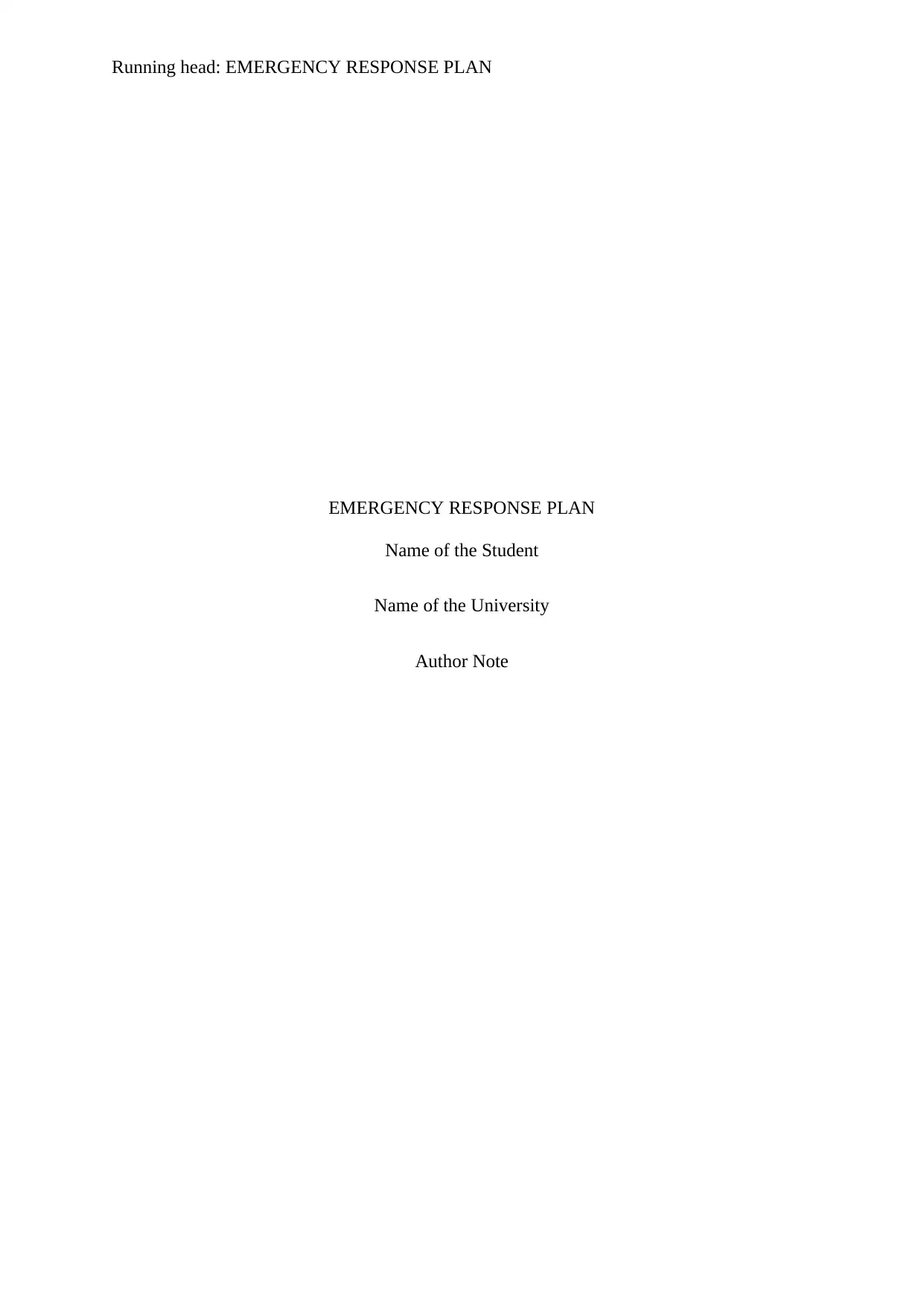
Running head: EMERGENCY RESPONSE PLAN
EMERGENCY RESPONSE PLAN
Name of the Student
Name of the University
Author Note
EMERGENCY RESPONSE PLAN
Name of the Student
Name of the University
Author Note
Secure Best Marks with AI Grader
Need help grading? Try our AI Grader for instant feedback on your assignments.
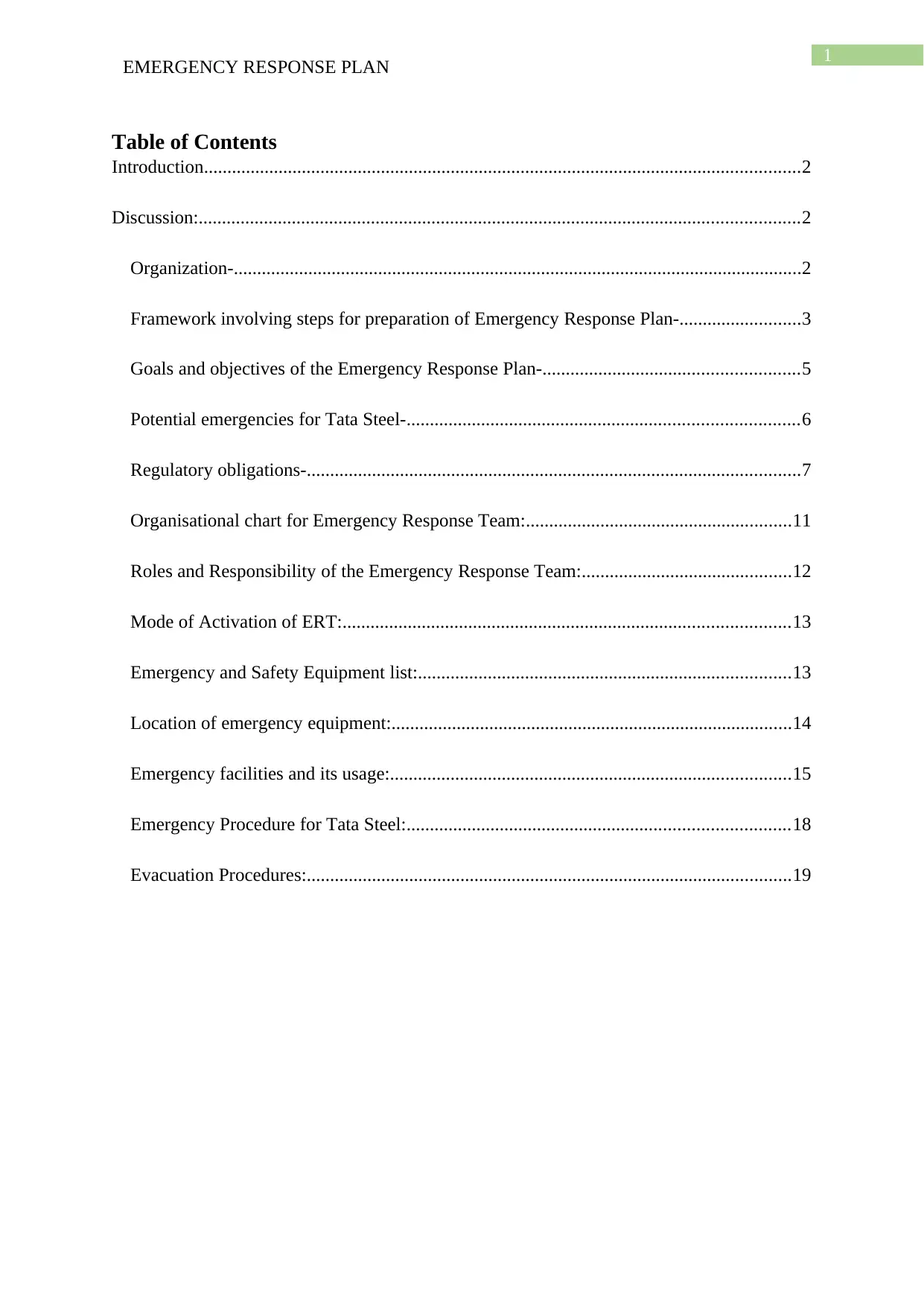
1
EMERGENCY RESPONSE PLAN
Table of Contents
Introduction................................................................................................................................2
Discussion:.................................................................................................................................2
Organization-..........................................................................................................................2
Framework involving steps for preparation of Emergency Response Plan-..........................3
Goals and objectives of the Emergency Response Plan-.......................................................5
Potential emergencies for Tata Steel-....................................................................................6
Regulatory obligations-..........................................................................................................7
Organisational chart for Emergency Response Team:.........................................................11
Roles and Responsibility of the Emergency Response Team:.............................................12
Mode of Activation of ERT:................................................................................................13
Emergency and Safety Equipment list:................................................................................13
Location of emergency equipment:......................................................................................14
Emergency facilities and its usage:......................................................................................15
Emergency Procedure for Tata Steel:..................................................................................18
Evacuation Procedures:........................................................................................................19
EMERGENCY RESPONSE PLAN
Table of Contents
Introduction................................................................................................................................2
Discussion:.................................................................................................................................2
Organization-..........................................................................................................................2
Framework involving steps for preparation of Emergency Response Plan-..........................3
Goals and objectives of the Emergency Response Plan-.......................................................5
Potential emergencies for Tata Steel-....................................................................................6
Regulatory obligations-..........................................................................................................7
Organisational chart for Emergency Response Team:.........................................................11
Roles and Responsibility of the Emergency Response Team:.............................................12
Mode of Activation of ERT:................................................................................................13
Emergency and Safety Equipment list:................................................................................13
Location of emergency equipment:......................................................................................14
Emergency facilities and its usage:......................................................................................15
Emergency Procedure for Tata Steel:..................................................................................18
Evacuation Procedures:........................................................................................................19
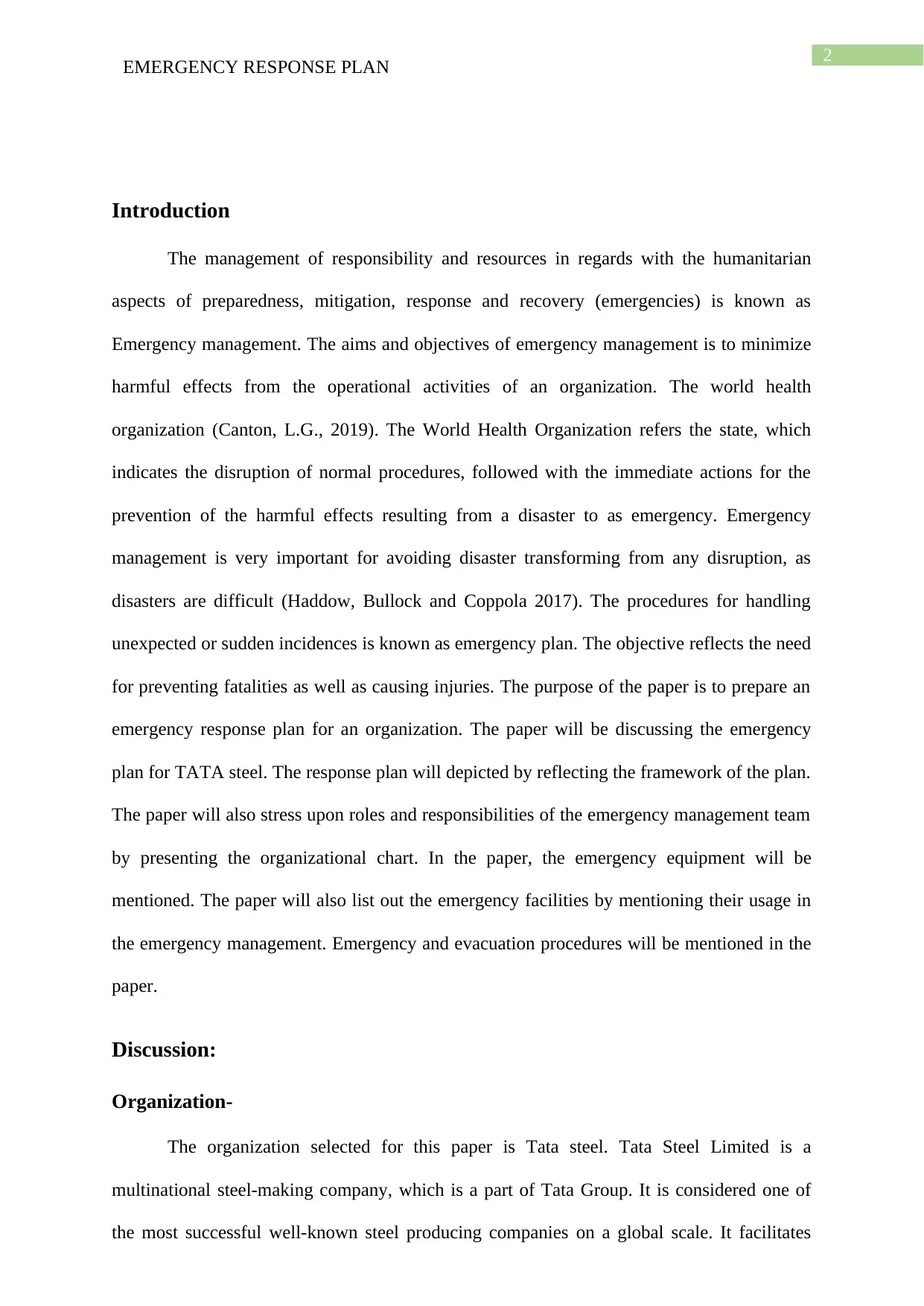
2
EMERGENCY RESPONSE PLAN
Introduction
The management of responsibility and resources in regards with the humanitarian
aspects of preparedness, mitigation, response and recovery (emergencies) is known as
Emergency management. The aims and objectives of emergency management is to minimize
harmful effects from the operational activities of an organization. The world health
organization (Canton, L.G., 2019). The World Health Organization refers the state, which
indicates the disruption of normal procedures, followed with the immediate actions for the
prevention of the harmful effects resulting from a disaster to as emergency. Emergency
management is very important for avoiding disaster transforming from any disruption, as
disasters are difficult (Haddow, Bullock and Coppola 2017). The procedures for handling
unexpected or sudden incidences is known as emergency plan. The objective reflects the need
for preventing fatalities as well as causing injuries. The purpose of the paper is to prepare an
emergency response plan for an organization. The paper will be discussing the emergency
plan for TATA steel. The response plan will depicted by reflecting the framework of the plan.
The paper will also stress upon roles and responsibilities of the emergency management team
by presenting the organizational chart. In the paper, the emergency equipment will be
mentioned. The paper will also list out the emergency facilities by mentioning their usage in
the emergency management. Emergency and evacuation procedures will be mentioned in the
paper.
Discussion:
Organization-
The organization selected for this paper is Tata steel. Tata Steel Limited is a
multinational steel-making company, which is a part of Tata Group. It is considered one of
the most successful well-known steel producing companies on a global scale. It facilitates
EMERGENCY RESPONSE PLAN
Introduction
The management of responsibility and resources in regards with the humanitarian
aspects of preparedness, mitigation, response and recovery (emergencies) is known as
Emergency management. The aims and objectives of emergency management is to minimize
harmful effects from the operational activities of an organization. The world health
organization (Canton, L.G., 2019). The World Health Organization refers the state, which
indicates the disruption of normal procedures, followed with the immediate actions for the
prevention of the harmful effects resulting from a disaster to as emergency. Emergency
management is very important for avoiding disaster transforming from any disruption, as
disasters are difficult (Haddow, Bullock and Coppola 2017). The procedures for handling
unexpected or sudden incidences is known as emergency plan. The objective reflects the need
for preventing fatalities as well as causing injuries. The purpose of the paper is to prepare an
emergency response plan for an organization. The paper will be discussing the emergency
plan for TATA steel. The response plan will depicted by reflecting the framework of the plan.
The paper will also stress upon roles and responsibilities of the emergency management team
by presenting the organizational chart. In the paper, the emergency equipment will be
mentioned. The paper will also list out the emergency facilities by mentioning their usage in
the emergency management. Emergency and evacuation procedures will be mentioned in the
paper.
Discussion:
Organization-
The organization selected for this paper is Tata steel. Tata Steel Limited is a
multinational steel-making company, which is a part of Tata Group. It is considered one of
the most successful well-known steel producing companies on a global scale. It facilitates
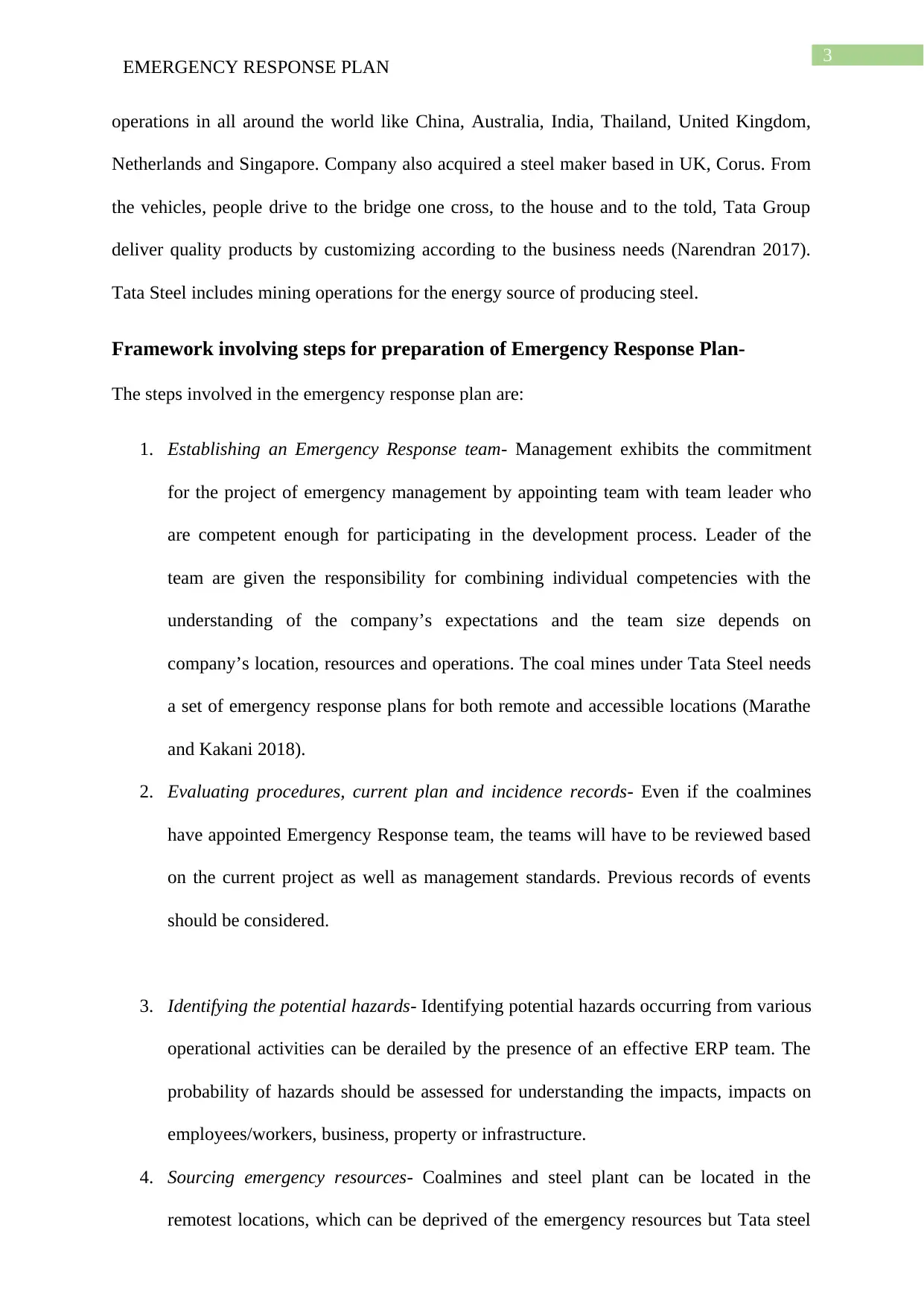
3
EMERGENCY RESPONSE PLAN
operations in all around the world like China, Australia, India, Thailand, United Kingdom,
Netherlands and Singapore. Company also acquired a steel maker based in UK, Corus. From
the vehicles, people drive to the bridge one cross, to the house and to the told, Tata Group
deliver quality products by customizing according to the business needs (Narendran 2017).
Tata Steel includes mining operations for the energy source of producing steel.
Framework involving steps for preparation of Emergency Response Plan-
The steps involved in the emergency response plan are:
1. Establishing an Emergency Response team- Management exhibits the commitment
for the project of emergency management by appointing team with team leader who
are competent enough for participating in the development process. Leader of the
team are given the responsibility for combining individual competencies with the
understanding of the company’s expectations and the team size depends on
company’s location, resources and operations. The coal mines under Tata Steel needs
a set of emergency response plans for both remote and accessible locations (Marathe
and Kakani 2018).
2. Evaluating procedures, current plan and incidence records- Even if the coalmines
have appointed Emergency Response team, the teams will have to be reviewed based
on the current project as well as management standards. Previous records of events
should be considered.
3. Identifying the potential hazards- Identifying potential hazards occurring from various
operational activities can be derailed by the presence of an effective ERP team. The
probability of hazards should be assessed for understanding the impacts, impacts on
employees/workers, business, property or infrastructure.
4. Sourcing emergency resources- Coalmines and steel plant can be located in the
remotest locations, which can be deprived of the emergency resources but Tata steel
EMERGENCY RESPONSE PLAN
operations in all around the world like China, Australia, India, Thailand, United Kingdom,
Netherlands and Singapore. Company also acquired a steel maker based in UK, Corus. From
the vehicles, people drive to the bridge one cross, to the house and to the told, Tata Group
deliver quality products by customizing according to the business needs (Narendran 2017).
Tata Steel includes mining operations for the energy source of producing steel.
Framework involving steps for preparation of Emergency Response Plan-
The steps involved in the emergency response plan are:
1. Establishing an Emergency Response team- Management exhibits the commitment
for the project of emergency management by appointing team with team leader who
are competent enough for participating in the development process. Leader of the
team are given the responsibility for combining individual competencies with the
understanding of the company’s expectations and the team size depends on
company’s location, resources and operations. The coal mines under Tata Steel needs
a set of emergency response plans for both remote and accessible locations (Marathe
and Kakani 2018).
2. Evaluating procedures, current plan and incidence records- Even if the coalmines
have appointed Emergency Response team, the teams will have to be reviewed based
on the current project as well as management standards. Previous records of events
should be considered.
3. Identifying the potential hazards- Identifying potential hazards occurring from various
operational activities can be derailed by the presence of an effective ERP team. The
probability of hazards should be assessed for understanding the impacts, impacts on
employees/workers, business, property or infrastructure.
4. Sourcing emergency resources- Coalmines and steel plant can be located in the
remotest locations, which can be deprived of the emergency resources but Tata steel
Secure Best Marks with AI Grader
Need help grading? Try our AI Grader for instant feedback on your assignments.
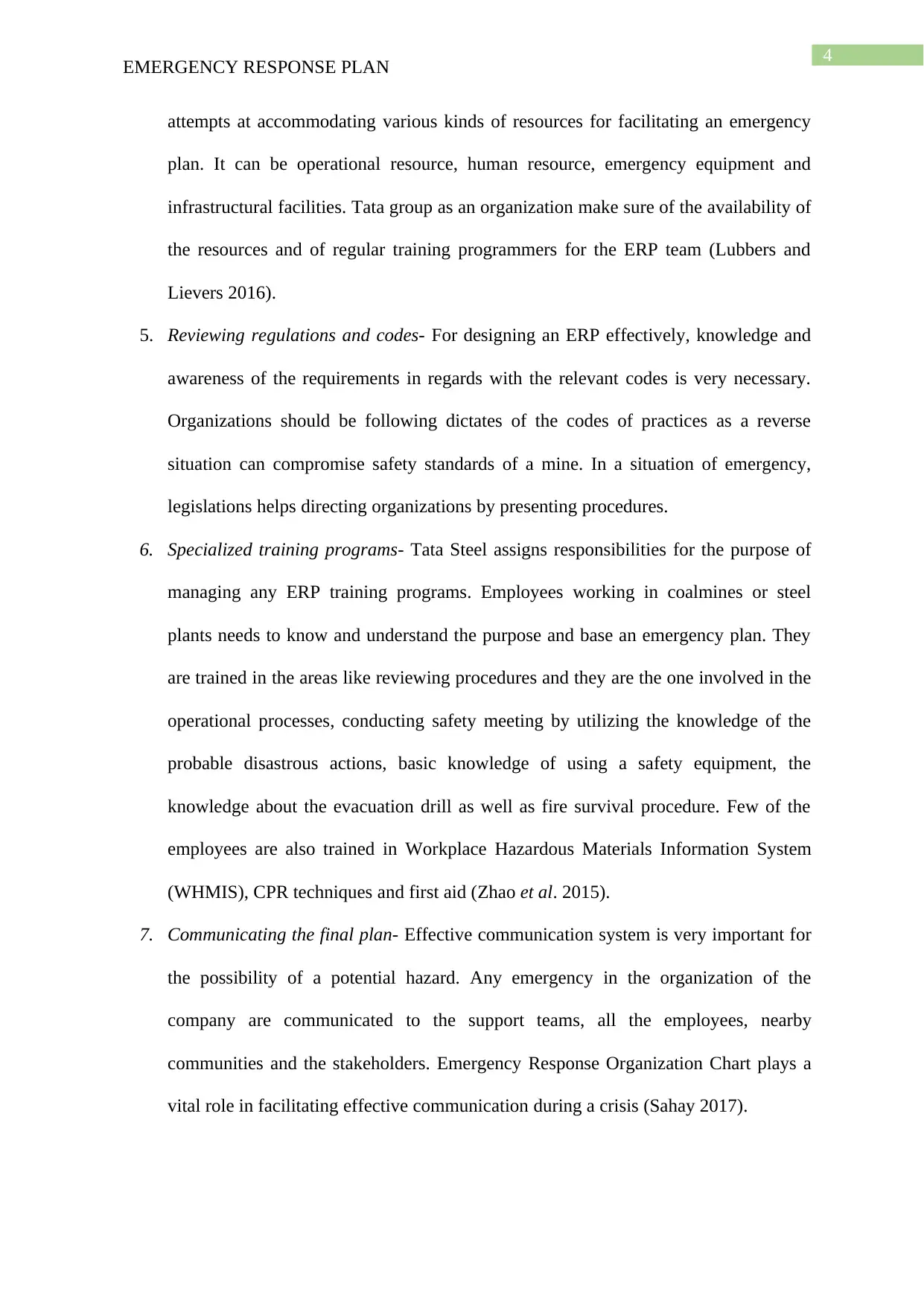
4
EMERGENCY RESPONSE PLAN
attempts at accommodating various kinds of resources for facilitating an emergency
plan. It can be operational resource, human resource, emergency equipment and
infrastructural facilities. Tata group as an organization make sure of the availability of
the resources and of regular training programmers for the ERP team (Lubbers and
Lievers 2016).
5. Reviewing regulations and codes- For designing an ERP effectively, knowledge and
awareness of the requirements in regards with the relevant codes is very necessary.
Organizations should be following dictates of the codes of practices as a reverse
situation can compromise safety standards of a mine. In a situation of emergency,
legislations helps directing organizations by presenting procedures.
6. Specialized training programs- Tata Steel assigns responsibilities for the purpose of
managing any ERP training programs. Employees working in coalmines or steel
plants needs to know and understand the purpose and base an emergency plan. They
are trained in the areas like reviewing procedures and they are the one involved in the
operational processes, conducting safety meeting by utilizing the knowledge of the
probable disastrous actions, basic knowledge of using a safety equipment, the
knowledge about the evacuation drill as well as fire survival procedure. Few of the
employees are also trained in Workplace Hazardous Materials Information System
(WHMIS), CPR techniques and first aid (Zhao et al. 2015).
7. Communicating the final plan- Effective communication system is very important for
the possibility of a potential hazard. Any emergency in the organization of the
company are communicated to the support teams, all the employees, nearby
communities and the stakeholders. Emergency Response Organization Chart plays a
vital role in facilitating effective communication during a crisis (Sahay 2017).
EMERGENCY RESPONSE PLAN
attempts at accommodating various kinds of resources for facilitating an emergency
plan. It can be operational resource, human resource, emergency equipment and
infrastructural facilities. Tata group as an organization make sure of the availability of
the resources and of regular training programmers for the ERP team (Lubbers and
Lievers 2016).
5. Reviewing regulations and codes- For designing an ERP effectively, knowledge and
awareness of the requirements in regards with the relevant codes is very necessary.
Organizations should be following dictates of the codes of practices as a reverse
situation can compromise safety standards of a mine. In a situation of emergency,
legislations helps directing organizations by presenting procedures.
6. Specialized training programs- Tata Steel assigns responsibilities for the purpose of
managing any ERP training programs. Employees working in coalmines or steel
plants needs to know and understand the purpose and base an emergency plan. They
are trained in the areas like reviewing procedures and they are the one involved in the
operational processes, conducting safety meeting by utilizing the knowledge of the
probable disastrous actions, basic knowledge of using a safety equipment, the
knowledge about the evacuation drill as well as fire survival procedure. Few of the
employees are also trained in Workplace Hazardous Materials Information System
(WHMIS), CPR techniques and first aid (Zhao et al. 2015).
7. Communicating the final plan- Effective communication system is very important for
the possibility of a potential hazard. Any emergency in the organization of the
company are communicated to the support teams, all the employees, nearby
communities and the stakeholders. Emergency Response Organization Chart plays a
vital role in facilitating effective communication during a crisis (Sahay 2017).
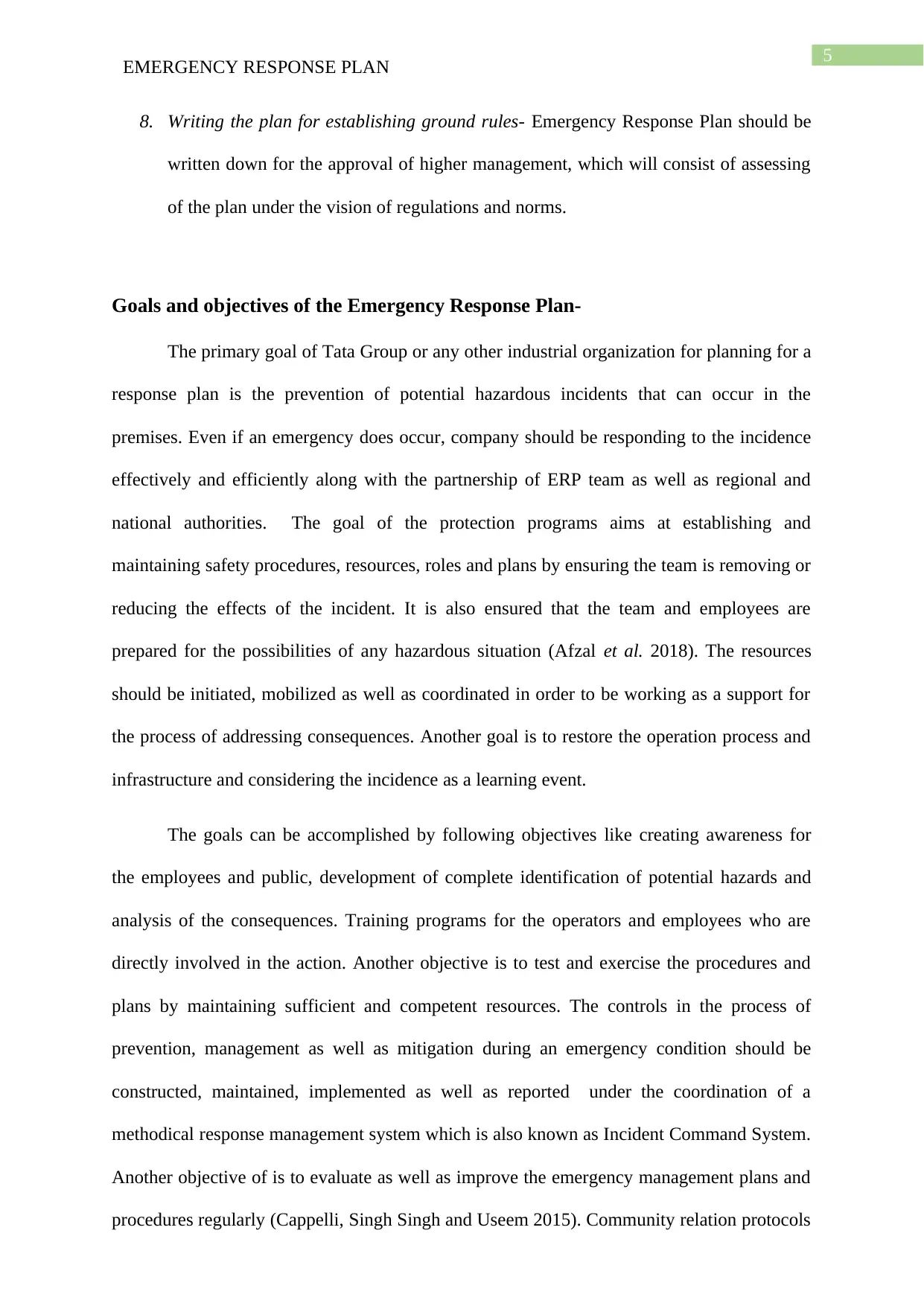
5
EMERGENCY RESPONSE PLAN
8. Writing the plan for establishing ground rules- Emergency Response Plan should be
written down for the approval of higher management, which will consist of assessing
of the plan under the vision of regulations and norms.
Goals and objectives of the Emergency Response Plan-
The primary goal of Tata Group or any other industrial organization for planning for a
response plan is the prevention of potential hazardous incidents that can occur in the
premises. Even if an emergency does occur, company should be responding to the incidence
effectively and efficiently along with the partnership of ERP team as well as regional and
national authorities. The goal of the protection programs aims at establishing and
maintaining safety procedures, resources, roles and plans by ensuring the team is removing or
reducing the effects of the incident. It is also ensured that the team and employees are
prepared for the possibilities of any hazardous situation (Afzal et al. 2018). The resources
should be initiated, mobilized as well as coordinated in order to be working as a support for
the process of addressing consequences. Another goal is to restore the operation process and
infrastructure and considering the incidence as a learning event.
The goals can be accomplished by following objectives like creating awareness for
the employees and public, development of complete identification of potential hazards and
analysis of the consequences. Training programs for the operators and employees who are
directly involved in the action. Another objective is to test and exercise the procedures and
plans by maintaining sufficient and competent resources. The controls in the process of
prevention, management as well as mitigation during an emergency condition should be
constructed, maintained, implemented as well as reported under the coordination of a
methodical response management system which is also known as Incident Command System.
Another objective of is to evaluate as well as improve the emergency management plans and
procedures regularly (Cappelli, Singh Singh and Useem 2015). Community relation protocols
EMERGENCY RESPONSE PLAN
8. Writing the plan for establishing ground rules- Emergency Response Plan should be
written down for the approval of higher management, which will consist of assessing
of the plan under the vision of regulations and norms.
Goals and objectives of the Emergency Response Plan-
The primary goal of Tata Group or any other industrial organization for planning for a
response plan is the prevention of potential hazardous incidents that can occur in the
premises. Even if an emergency does occur, company should be responding to the incidence
effectively and efficiently along with the partnership of ERP team as well as regional and
national authorities. The goal of the protection programs aims at establishing and
maintaining safety procedures, resources, roles and plans by ensuring the team is removing or
reducing the effects of the incident. It is also ensured that the team and employees are
prepared for the possibilities of any hazardous situation (Afzal et al. 2018). The resources
should be initiated, mobilized as well as coordinated in order to be working as a support for
the process of addressing consequences. Another goal is to restore the operation process and
infrastructure and considering the incidence as a learning event.
The goals can be accomplished by following objectives like creating awareness for
the employees and public, development of complete identification of potential hazards and
analysis of the consequences. Training programs for the operators and employees who are
directly involved in the action. Another objective is to test and exercise the procedures and
plans by maintaining sufficient and competent resources. The controls in the process of
prevention, management as well as mitigation during an emergency condition should be
constructed, maintained, implemented as well as reported under the coordination of a
methodical response management system which is also known as Incident Command System.
Another objective of is to evaluate as well as improve the emergency management plans and
procedures regularly (Cappelli, Singh Singh and Useem 2015). Community relation protocols
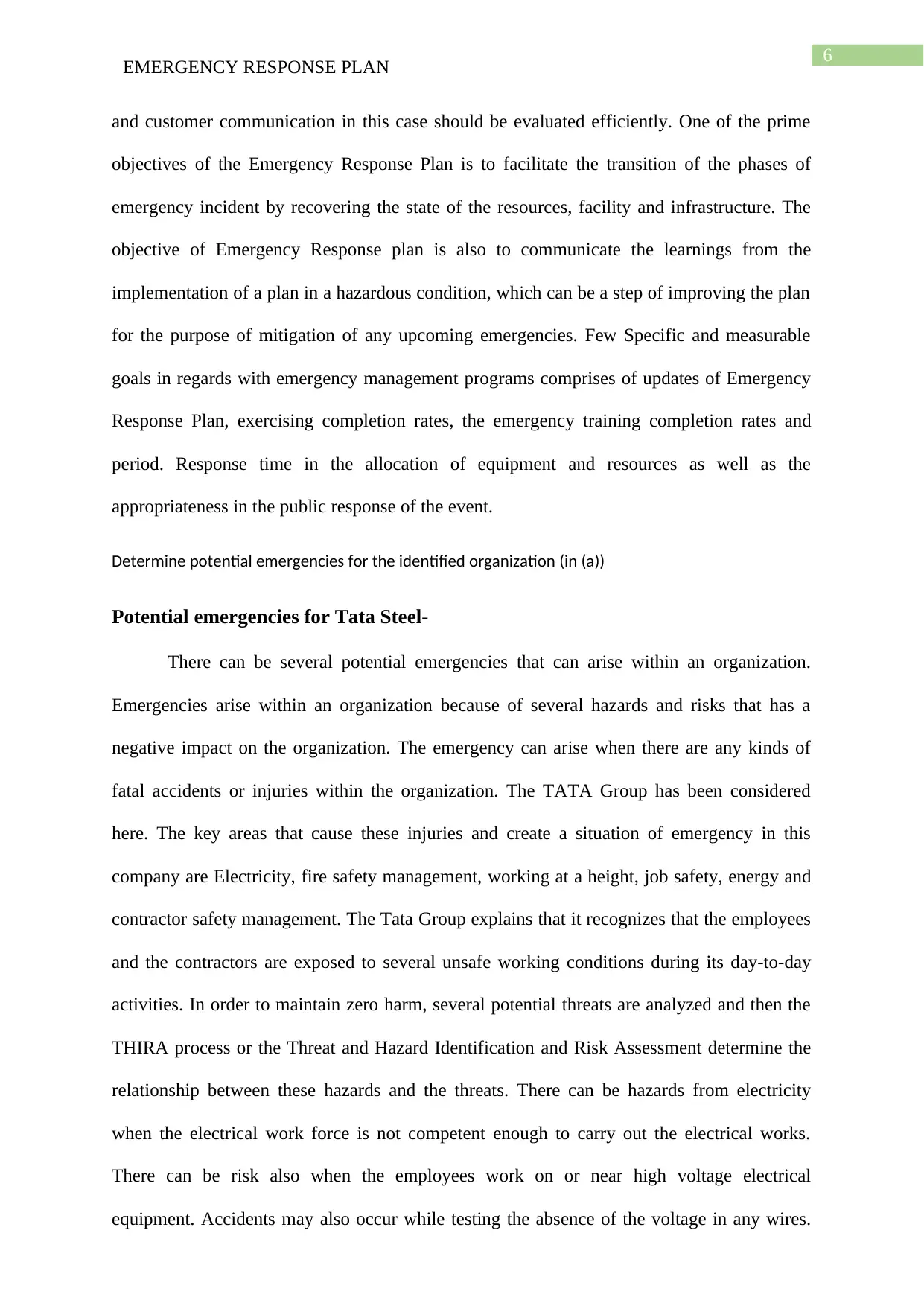
6
EMERGENCY RESPONSE PLAN
and customer communication in this case should be evaluated efficiently. One of the prime
objectives of the Emergency Response Plan is to facilitate the transition of the phases of
emergency incident by recovering the state of the resources, facility and infrastructure. The
objective of Emergency Response plan is also to communicate the learnings from the
implementation of a plan in a hazardous condition, which can be a step of improving the plan
for the purpose of mitigation of any upcoming emergencies. Few Specific and measurable
goals in regards with emergency management programs comprises of updates of Emergency
Response Plan, exercising completion rates, the emergency training completion rates and
period. Response time in the allocation of equipment and resources as well as the
appropriateness in the public response of the event.
Determine potential emergencies for the identified organization (in (a))
Potential emergencies for Tata Steel-
There can be several potential emergencies that can arise within an organization.
Emergencies arise within an organization because of several hazards and risks that has a
negative impact on the organization. The emergency can arise when there are any kinds of
fatal accidents or injuries within the organization. The TATA Group has been considered
here. The key areas that cause these injuries and create a situation of emergency in this
company are Electricity, fire safety management, working at a height, job safety, energy and
contractor safety management. The Tata Group explains that it recognizes that the employees
and the contractors are exposed to several unsafe working conditions during its day-to-day
activities. In order to maintain zero harm, several potential threats are analyzed and then the
THIRA process or the Threat and Hazard Identification and Risk Assessment determine the
relationship between these hazards and the threats. There can be hazards from electricity
when the electrical work force is not competent enough to carry out the electrical works.
There can be risk also when the employees work on or near high voltage electrical
equipment. Accidents may also occur while testing the absence of the voltage in any wires.
EMERGENCY RESPONSE PLAN
and customer communication in this case should be evaluated efficiently. One of the prime
objectives of the Emergency Response Plan is to facilitate the transition of the phases of
emergency incident by recovering the state of the resources, facility and infrastructure. The
objective of Emergency Response plan is also to communicate the learnings from the
implementation of a plan in a hazardous condition, which can be a step of improving the plan
for the purpose of mitigation of any upcoming emergencies. Few Specific and measurable
goals in regards with emergency management programs comprises of updates of Emergency
Response Plan, exercising completion rates, the emergency training completion rates and
period. Response time in the allocation of equipment and resources as well as the
appropriateness in the public response of the event.
Determine potential emergencies for the identified organization (in (a))
Potential emergencies for Tata Steel-
There can be several potential emergencies that can arise within an organization.
Emergencies arise within an organization because of several hazards and risks that has a
negative impact on the organization. The emergency can arise when there are any kinds of
fatal accidents or injuries within the organization. The TATA Group has been considered
here. The key areas that cause these injuries and create a situation of emergency in this
company are Electricity, fire safety management, working at a height, job safety, energy and
contractor safety management. The Tata Group explains that it recognizes that the employees
and the contractors are exposed to several unsafe working conditions during its day-to-day
activities. In order to maintain zero harm, several potential threats are analyzed and then the
THIRA process or the Threat and Hazard Identification and Risk Assessment determine the
relationship between these hazards and the threats. There can be hazards from electricity
when the electrical work force is not competent enough to carry out the electrical works.
There can be risk also when the employees work on or near high voltage electrical
equipment. Accidents may also occur while testing the absence of the voltage in any wires.
Paraphrase This Document
Need a fresh take? Get an instant paraphrase of this document with our AI Paraphraser
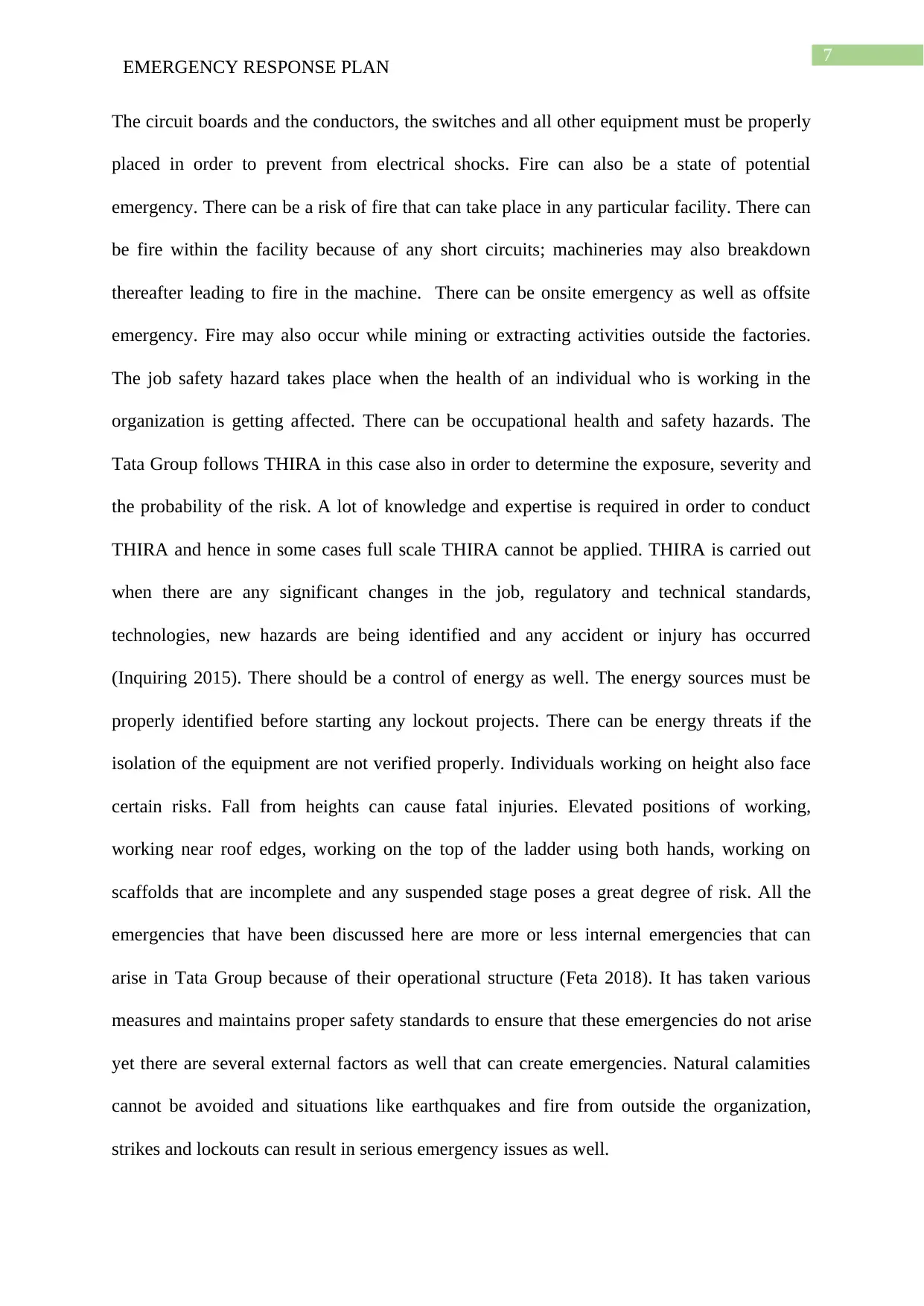
7
EMERGENCY RESPONSE PLAN
The circuit boards and the conductors, the switches and all other equipment must be properly
placed in order to prevent from electrical shocks. Fire can also be a state of potential
emergency. There can be a risk of fire that can take place in any particular facility. There can
be fire within the facility because of any short circuits; machineries may also breakdown
thereafter leading to fire in the machine. There can be onsite emergency as well as offsite
emergency. Fire may also occur while mining or extracting activities outside the factories.
The job safety hazard takes place when the health of an individual who is working in the
organization is getting affected. There can be occupational health and safety hazards. The
Tata Group follows THIRA in this case also in order to determine the exposure, severity and
the probability of the risk. A lot of knowledge and expertise is required in order to conduct
THIRA and hence in some cases full scale THIRA cannot be applied. THIRA is carried out
when there are any significant changes in the job, regulatory and technical standards,
technologies, new hazards are being identified and any accident or injury has occurred
(Inquiring 2015). There should be a control of energy as well. The energy sources must be
properly identified before starting any lockout projects. There can be energy threats if the
isolation of the equipment are not verified properly. Individuals working on height also face
certain risks. Fall from heights can cause fatal injuries. Elevated positions of working,
working near roof edges, working on the top of the ladder using both hands, working on
scaffolds that are incomplete and any suspended stage poses a great degree of risk. All the
emergencies that have been discussed here are more or less internal emergencies that can
arise in Tata Group because of their operational structure (Feta 2018). It has taken various
measures and maintains proper safety standards to ensure that these emergencies do not arise
yet there are several external factors as well that can create emergencies. Natural calamities
cannot be avoided and situations like earthquakes and fire from outside the organization,
strikes and lockouts can result in serious emergency issues as well.
EMERGENCY RESPONSE PLAN
The circuit boards and the conductors, the switches and all other equipment must be properly
placed in order to prevent from electrical shocks. Fire can also be a state of potential
emergency. There can be a risk of fire that can take place in any particular facility. There can
be fire within the facility because of any short circuits; machineries may also breakdown
thereafter leading to fire in the machine. There can be onsite emergency as well as offsite
emergency. Fire may also occur while mining or extracting activities outside the factories.
The job safety hazard takes place when the health of an individual who is working in the
organization is getting affected. There can be occupational health and safety hazards. The
Tata Group follows THIRA in this case also in order to determine the exposure, severity and
the probability of the risk. A lot of knowledge and expertise is required in order to conduct
THIRA and hence in some cases full scale THIRA cannot be applied. THIRA is carried out
when there are any significant changes in the job, regulatory and technical standards,
technologies, new hazards are being identified and any accident or injury has occurred
(Inquiring 2015). There should be a control of energy as well. The energy sources must be
properly identified before starting any lockout projects. There can be energy threats if the
isolation of the equipment are not verified properly. Individuals working on height also face
certain risks. Fall from heights can cause fatal injuries. Elevated positions of working,
working near roof edges, working on the top of the ladder using both hands, working on
scaffolds that are incomplete and any suspended stage poses a great degree of risk. All the
emergencies that have been discussed here are more or less internal emergencies that can
arise in Tata Group because of their operational structure (Feta 2018). It has taken various
measures and maintains proper safety standards to ensure that these emergencies do not arise
yet there are several external factors as well that can create emergencies. Natural calamities
cannot be avoided and situations like earthquakes and fire from outside the organization,
strikes and lockouts can result in serious emergency issues as well.
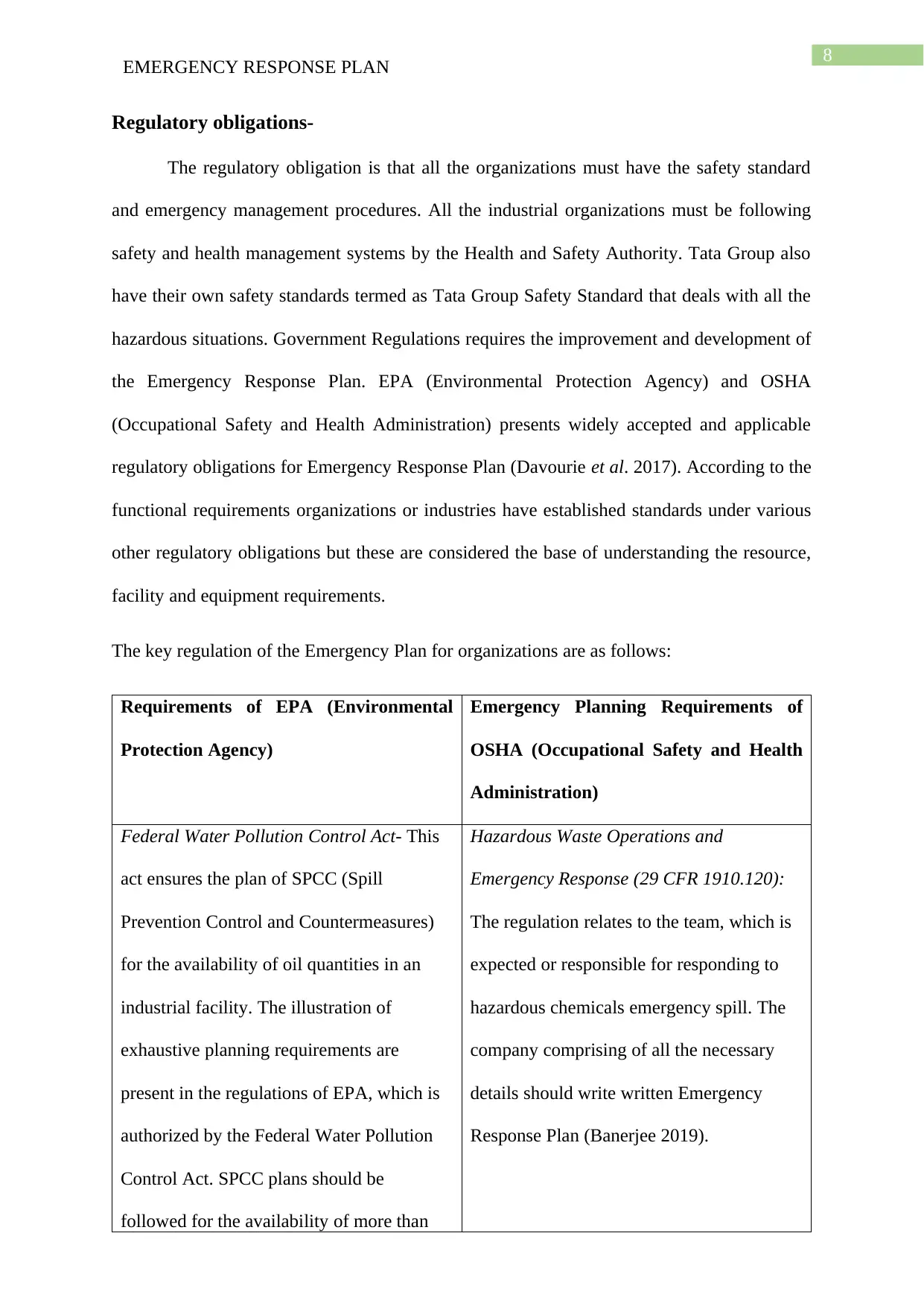
8
EMERGENCY RESPONSE PLAN
Regulatory obligations-
The regulatory obligation is that all the organizations must have the safety standard
and emergency management procedures. All the industrial organizations must be following
safety and health management systems by the Health and Safety Authority. Tata Group also
have their own safety standards termed as Tata Group Safety Standard that deals with all the
hazardous situations. Government Regulations requires the improvement and development of
the Emergency Response Plan. EPA (Environmental Protection Agency) and OSHA
(Occupational Safety and Health Administration) presents widely accepted and applicable
regulatory obligations for Emergency Response Plan (Davourie et al. 2017). According to the
functional requirements organizations or industries have established standards under various
other regulatory obligations but these are considered the base of understanding the resource,
facility and equipment requirements.
The key regulation of the Emergency Plan for organizations are as follows:
Requirements of EPA (Environmental
Protection Agency)
Emergency Planning Requirements of
OSHA (Occupational Safety and Health
Administration)
Federal Water Pollution Control Act- This
act ensures the plan of SPCC (Spill
Prevention Control and Countermeasures)
for the availability of oil quantities in an
industrial facility. The illustration of
exhaustive planning requirements are
present in the regulations of EPA, which is
authorized by the Federal Water Pollution
Control Act. SPCC plans should be
followed for the availability of more than
Hazardous Waste Operations and
Emergency Response (29 CFR 1910.120):
The regulation relates to the team, which is
expected or responsible for responding to
hazardous chemicals emergency spill. The
company comprising of all the necessary
details should write written Emergency
Response Plan (Banerjee 2019).
EMERGENCY RESPONSE PLAN
Regulatory obligations-
The regulatory obligation is that all the organizations must have the safety standard
and emergency management procedures. All the industrial organizations must be following
safety and health management systems by the Health and Safety Authority. Tata Group also
have their own safety standards termed as Tata Group Safety Standard that deals with all the
hazardous situations. Government Regulations requires the improvement and development of
the Emergency Response Plan. EPA (Environmental Protection Agency) and OSHA
(Occupational Safety and Health Administration) presents widely accepted and applicable
regulatory obligations for Emergency Response Plan (Davourie et al. 2017). According to the
functional requirements organizations or industries have established standards under various
other regulatory obligations but these are considered the base of understanding the resource,
facility and equipment requirements.
The key regulation of the Emergency Plan for organizations are as follows:
Requirements of EPA (Environmental
Protection Agency)
Emergency Planning Requirements of
OSHA (Occupational Safety and Health
Administration)
Federal Water Pollution Control Act- This
act ensures the plan of SPCC (Spill
Prevention Control and Countermeasures)
for the availability of oil quantities in an
industrial facility. The illustration of
exhaustive planning requirements are
present in the regulations of EPA, which is
authorized by the Federal Water Pollution
Control Act. SPCC plans should be
followed for the availability of more than
Hazardous Waste Operations and
Emergency Response (29 CFR 1910.120):
The regulation relates to the team, which is
expected or responsible for responding to
hazardous chemicals emergency spill. The
company comprising of all the necessary
details should write written Emergency
Response Plan (Banerjee 2019).
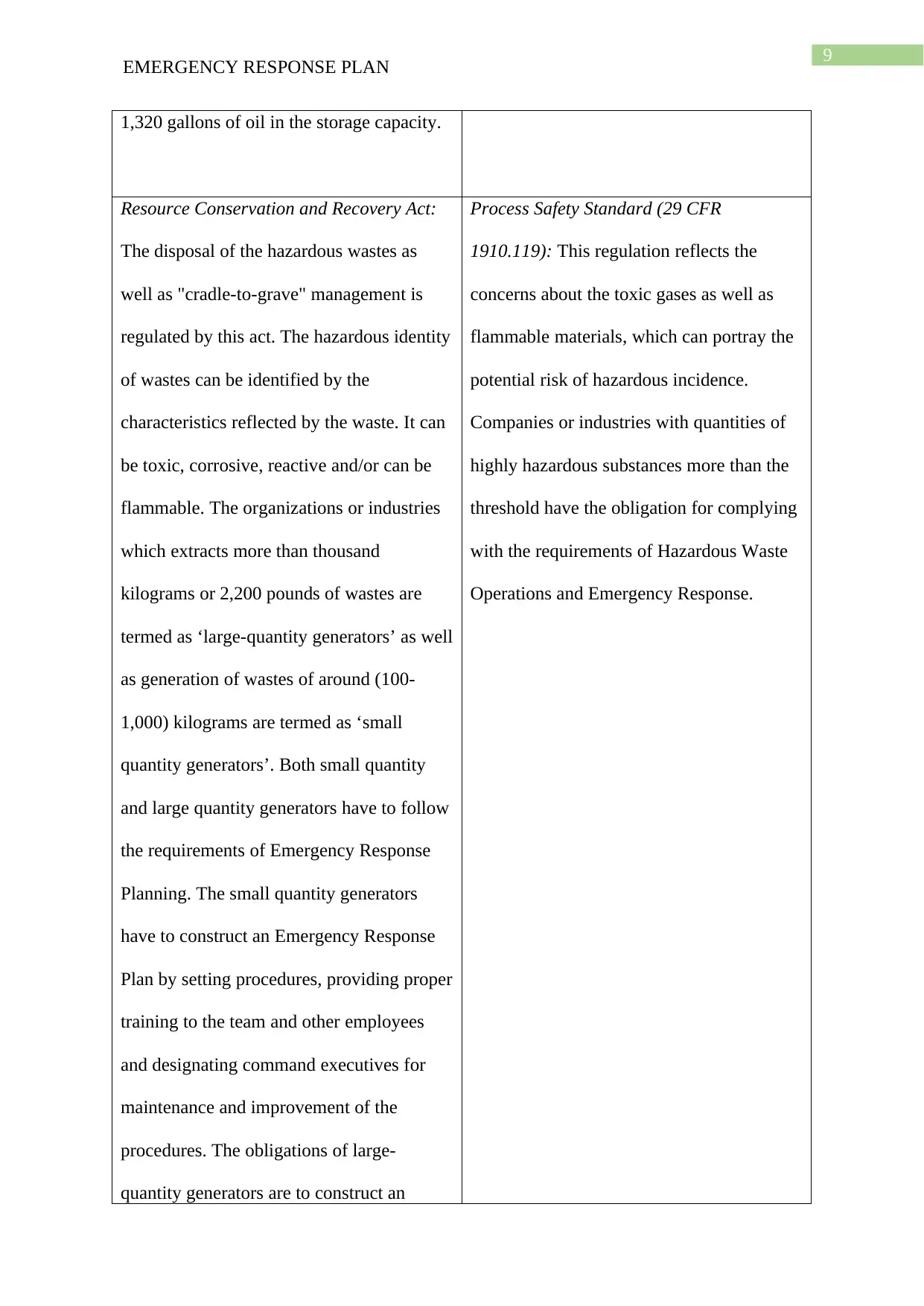
9
EMERGENCY RESPONSE PLAN
1,320 gallons of oil in the storage capacity.
Resource Conservation and Recovery Act:
The disposal of the hazardous wastes as
well as "cradle-to-grave" management is
regulated by this act. The hazardous identity
of wastes can be identified by the
characteristics reflected by the waste. It can
be toxic, corrosive, reactive and/or can be
flammable. The organizations or industries
which extracts more than thousand
kilograms or 2,200 pounds of wastes are
termed as ‘large-quantity generators’ as well
as generation of wastes of around (100-
1,000) kilograms are termed as ‘small
quantity generators’. Both small quantity
and large quantity generators have to follow
the requirements of Emergency Response
Planning. The small quantity generators
have to construct an Emergency Response
Plan by setting procedures, providing proper
training to the team and other employees
and designating command executives for
maintenance and improvement of the
procedures. The obligations of large-
quantity generators are to construct an
Process Safety Standard (29 CFR
1910.119): This regulation reflects the
concerns about the toxic gases as well as
flammable materials, which can portray the
potential risk of hazardous incidence.
Companies or industries with quantities of
highly hazardous substances more than the
threshold have the obligation for complying
with the requirements of Hazardous Waste
Operations and Emergency Response.
EMERGENCY RESPONSE PLAN
1,320 gallons of oil in the storage capacity.
Resource Conservation and Recovery Act:
The disposal of the hazardous wastes as
well as "cradle-to-grave" management is
regulated by this act. The hazardous identity
of wastes can be identified by the
characteristics reflected by the waste. It can
be toxic, corrosive, reactive and/or can be
flammable. The organizations or industries
which extracts more than thousand
kilograms or 2,200 pounds of wastes are
termed as ‘large-quantity generators’ as well
as generation of wastes of around (100-
1,000) kilograms are termed as ‘small
quantity generators’. Both small quantity
and large quantity generators have to follow
the requirements of Emergency Response
Planning. The small quantity generators
have to construct an Emergency Response
Plan by setting procedures, providing proper
training to the team and other employees
and designating command executives for
maintenance and improvement of the
procedures. The obligations of large-
quantity generators are to construct an
Process Safety Standard (29 CFR
1910.119): This regulation reflects the
concerns about the toxic gases as well as
flammable materials, which can portray the
potential risk of hazardous incidence.
Companies or industries with quantities of
highly hazardous substances more than the
threshold have the obligation for complying
with the requirements of Hazardous Waste
Operations and Emergency Response.
Secure Best Marks with AI Grader
Need help grading? Try our AI Grader for instant feedback on your assignments.
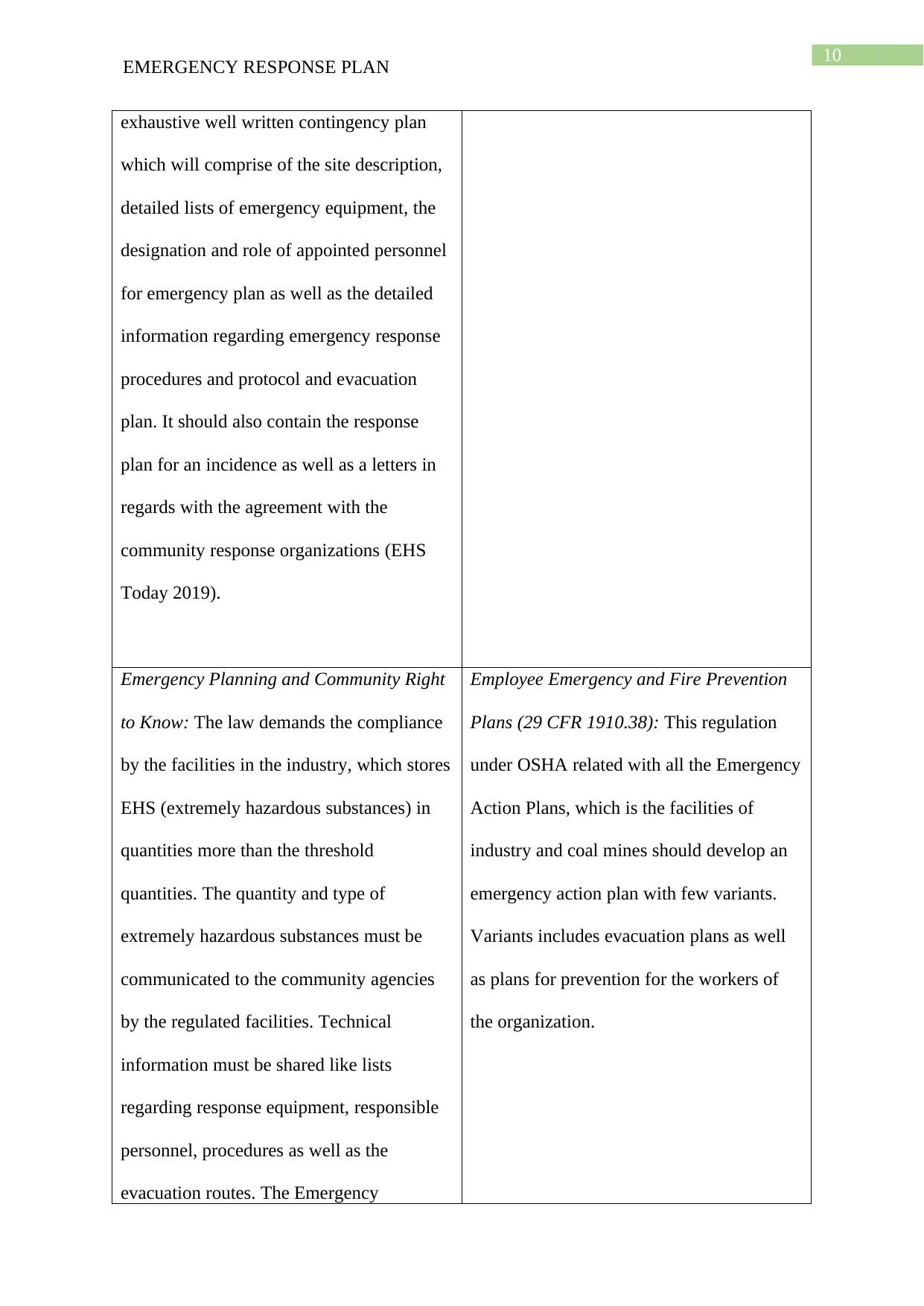
10
EMERGENCY RESPONSE PLAN
exhaustive well written contingency plan
which will comprise of the site description,
detailed lists of emergency equipment, the
designation and role of appointed personnel
for emergency plan as well as the detailed
information regarding emergency response
procedures and protocol and evacuation
plan. It should also contain the response
plan for an incidence as well as a letters in
regards with the agreement with the
community response organizations (EHS
Today 2019).
Emergency Planning and Community Right
to Know: The law demands the compliance
by the facilities in the industry, which stores
EHS (extremely hazardous substances) in
quantities more than the threshold
quantities. The quantity and type of
extremely hazardous substances must be
communicated to the community agencies
by the regulated facilities. Technical
information must be shared like lists
regarding response equipment, responsible
personnel, procedures as well as the
evacuation routes. The Emergency
Employee Emergency and Fire Prevention
Plans (29 CFR 1910.38): This regulation
under OSHA related with all the Emergency
Action Plans, which is the facilities of
industry and coal mines should develop an
emergency action plan with few variants.
Variants includes evacuation plans as well
as plans for prevention for the workers of
the organization.
EMERGENCY RESPONSE PLAN
exhaustive well written contingency plan
which will comprise of the site description,
detailed lists of emergency equipment, the
designation and role of appointed personnel
for emergency plan as well as the detailed
information regarding emergency response
procedures and protocol and evacuation
plan. It should also contain the response
plan for an incidence as well as a letters in
regards with the agreement with the
community response organizations (EHS
Today 2019).
Emergency Planning and Community Right
to Know: The law demands the compliance
by the facilities in the industry, which stores
EHS (extremely hazardous substances) in
quantities more than the threshold
quantities. The quantity and type of
extremely hazardous substances must be
communicated to the community agencies
by the regulated facilities. Technical
information must be shared like lists
regarding response equipment, responsible
personnel, procedures as well as the
evacuation routes. The Emergency
Employee Emergency and Fire Prevention
Plans (29 CFR 1910.38): This regulation
under OSHA related with all the Emergency
Action Plans, which is the facilities of
industry and coal mines should develop an
emergency action plan with few variants.
Variants includes evacuation plans as well
as plans for prevention for the workers of
the organization.
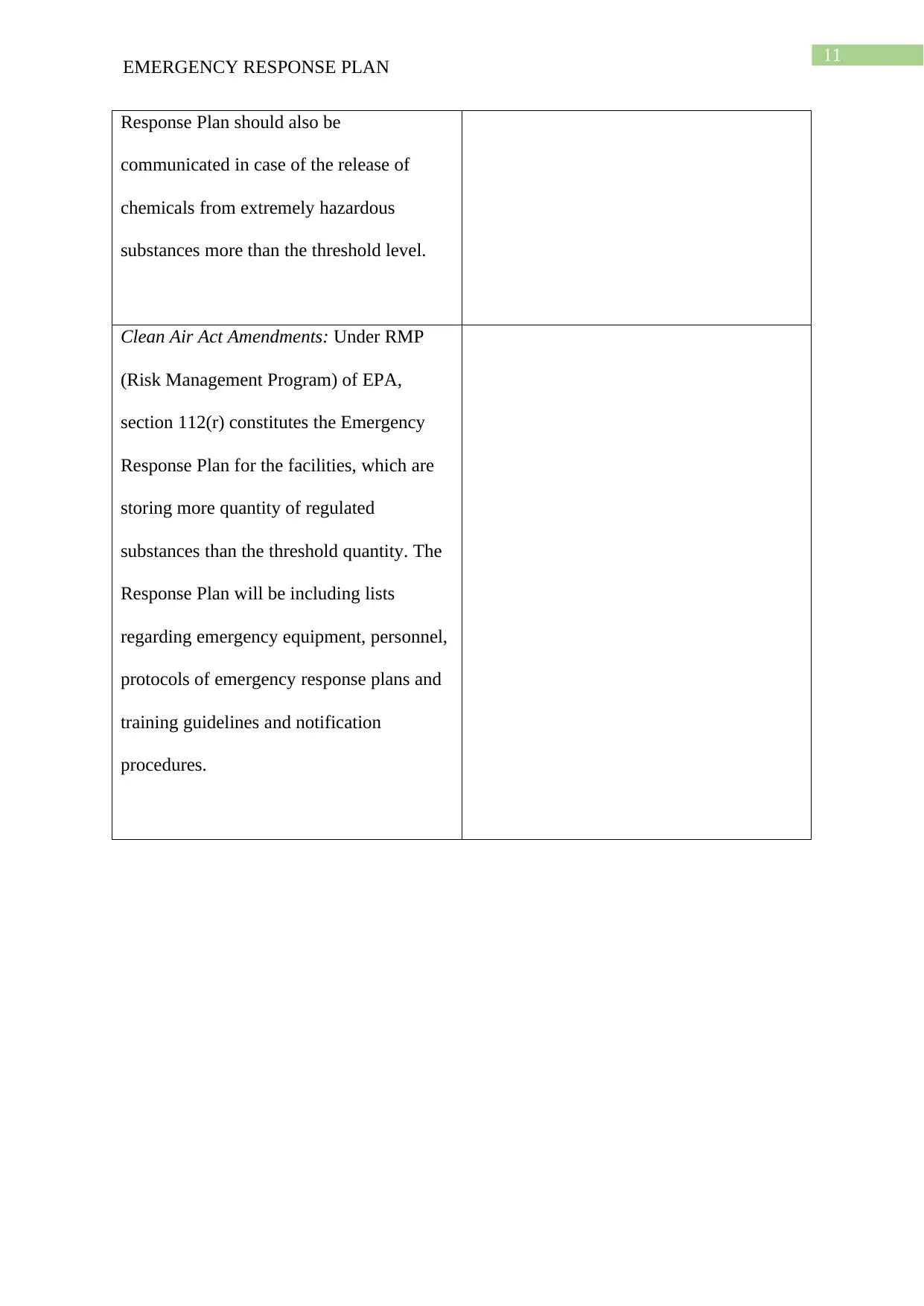
11
EMERGENCY RESPONSE PLAN
Response Plan should also be
communicated in case of the release of
chemicals from extremely hazardous
substances more than the threshold level.
Clean Air Act Amendments: Under RMP
(Risk Management Program) of EPA,
section 112(r) constitutes the Emergency
Response Plan for the facilities, which are
storing more quantity of regulated
substances than the threshold quantity. The
Response Plan will be including lists
regarding emergency equipment, personnel,
protocols of emergency response plans and
training guidelines and notification
procedures.
EMERGENCY RESPONSE PLAN
Response Plan should also be
communicated in case of the release of
chemicals from extremely hazardous
substances more than the threshold level.
Clean Air Act Amendments: Under RMP
(Risk Management Program) of EPA,
section 112(r) constitutes the Emergency
Response Plan for the facilities, which are
storing more quantity of regulated
substances than the threshold quantity. The
Response Plan will be including lists
regarding emergency equipment, personnel,
protocols of emergency response plans and
training guidelines and notification
procedures.
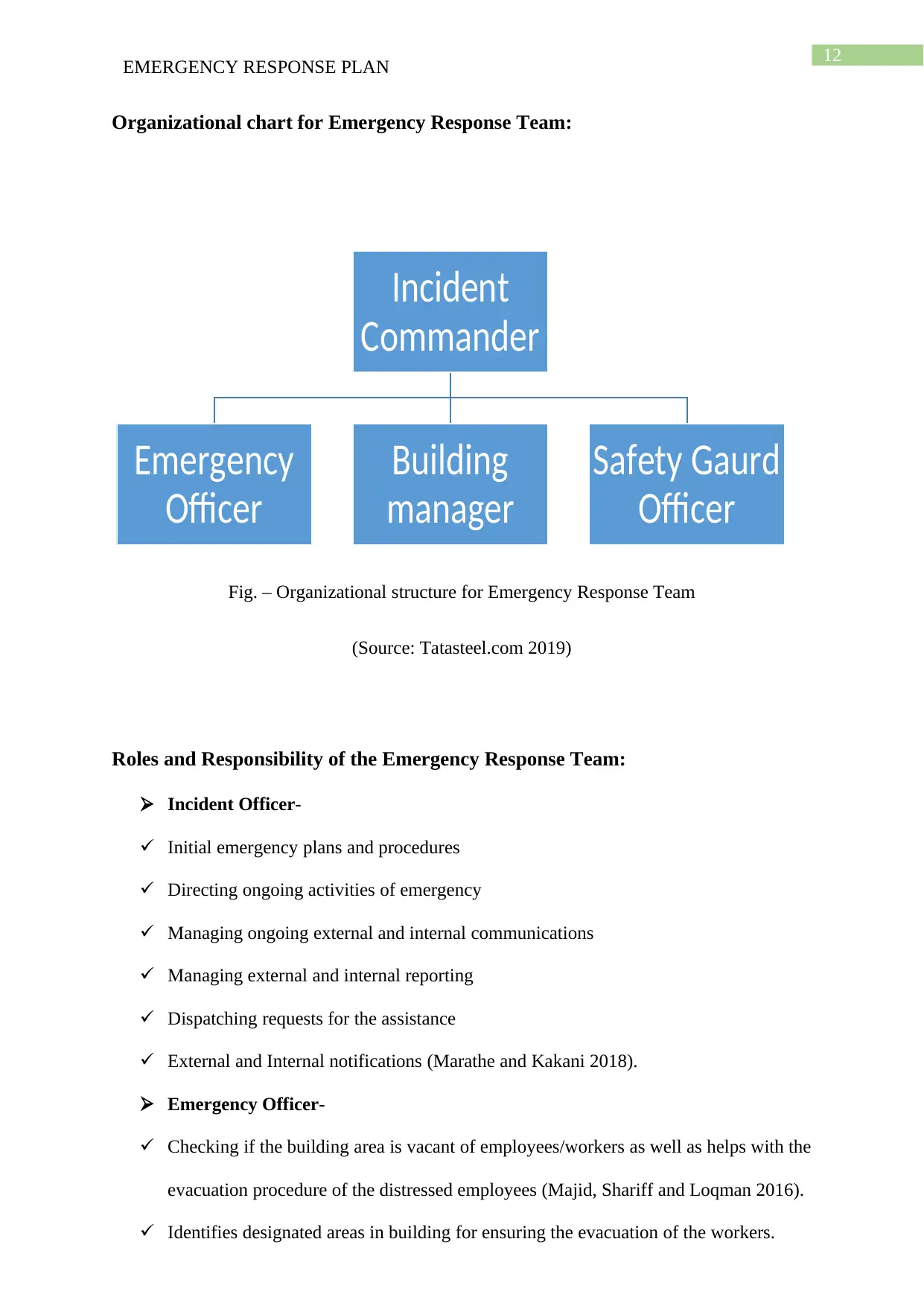
12
EMERGENCY RESPONSE PLAN
Organizational chart for Emergency Response Team:
Fig. – Organizational structure for Emergency Response Team
(Source: Tatasteel.com 2019)
Roles and Responsibility of the Emergency Response Team:
Incident Officer-
Initial emergency plans and procedures
Directing ongoing activities of emergency
Managing ongoing external and internal communications
Managing external and internal reporting
Dispatching requests for the assistance
External and Internal notifications (Marathe and Kakani 2018).
Emergency Officer-
Checking if the building area is vacant of employees/workers as well as helps with the
evacuation procedure of the distressed employees (Majid, Shariff and Loqman 2016).
Identifies designated areas in building for ensuring the evacuation of the workers.
Incident
Commander
Emergency
Officer
Building
manager
Safety Gaurd
Officer
EMERGENCY RESPONSE PLAN
Organizational chart for Emergency Response Team:
Fig. – Organizational structure for Emergency Response Team
(Source: Tatasteel.com 2019)
Roles and Responsibility of the Emergency Response Team:
Incident Officer-
Initial emergency plans and procedures
Directing ongoing activities of emergency
Managing ongoing external and internal communications
Managing external and internal reporting
Dispatching requests for the assistance
External and Internal notifications (Marathe and Kakani 2018).
Emergency Officer-
Checking if the building area is vacant of employees/workers as well as helps with the
evacuation procedure of the distressed employees (Majid, Shariff and Loqman 2016).
Identifies designated areas in building for ensuring the evacuation of the workers.
Incident
Commander
Emergency
Officer
Building
manager
Safety Gaurd
Officer
Paraphrase This Document
Need a fresh take? Get an instant paraphrase of this document with our AI Paraphraser
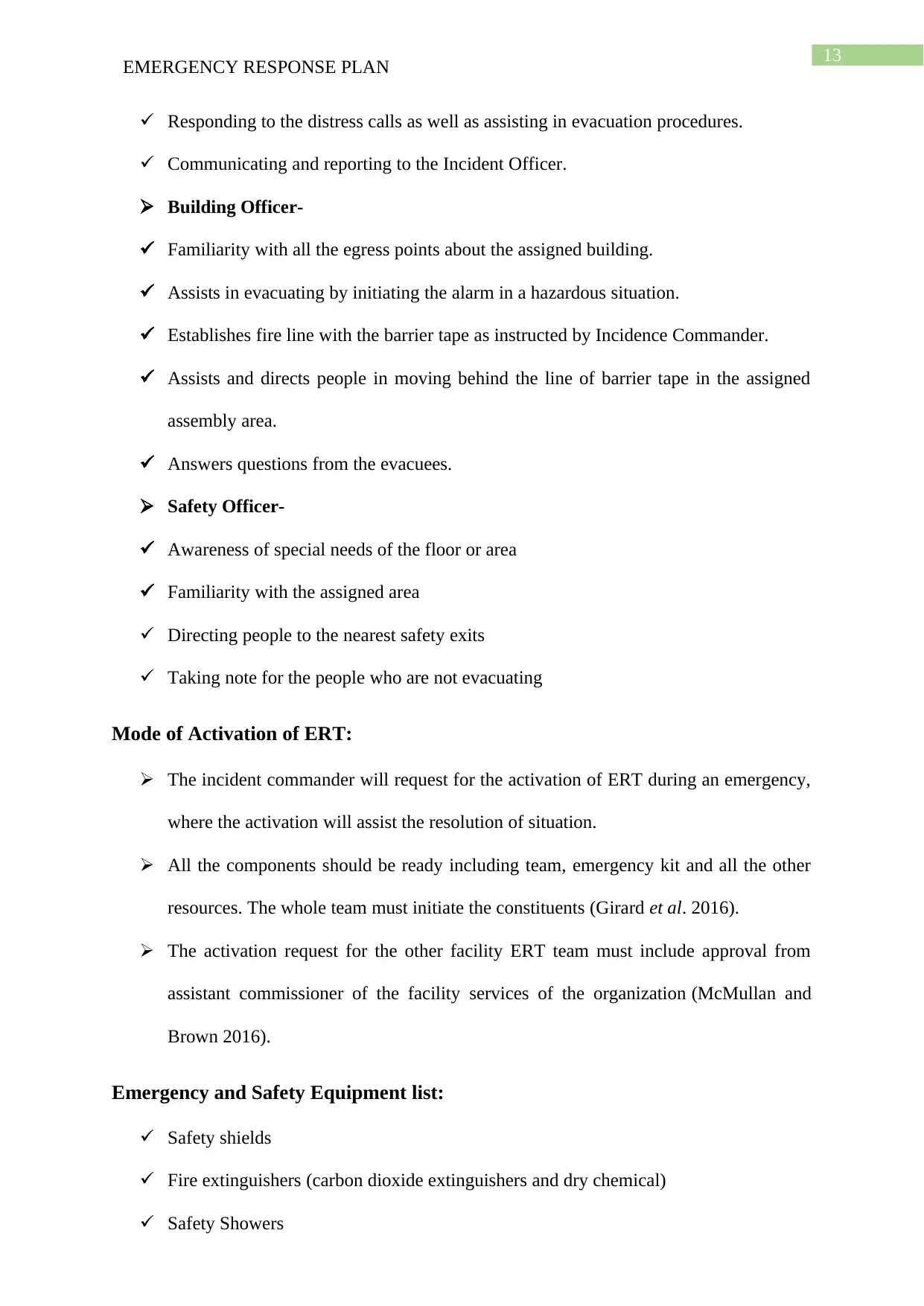
13
EMERGENCY RESPONSE PLAN
Responding to the distress calls as well as assisting in evacuation procedures.
Communicating and reporting to the Incident Officer.
Building Officer-
Familiarity with all the egress points about the assigned building.
Assists in evacuating by initiating the alarm in a hazardous situation.
Establishes fire line with the barrier tape as instructed by Incidence Commander.
Assists and directs people in moving behind the line of barrier tape in the assigned
assembly area.
Answers questions from the evacuees.
Safety Officer-
Awareness of special needs of the floor or area
Familiarity with the assigned area
Directing people to the nearest safety exits
Taking note for the people who are not evacuating
Mode of Activation of ERT:
The incident commander will request for the activation of ERT during an emergency,
where the activation will assist the resolution of situation.
All the components should be ready including team, emergency kit and all the other
resources. The whole team must initiate the constituents (Girard et al. 2016).
The activation request for the other facility ERT team must include approval from
assistant commissioner of the facility services of the organization (McMullan and
Brown 2016).
Emergency and Safety Equipment list:
Safety shields
Fire extinguishers (carbon dioxide extinguishers and dry chemical)
Safety Showers
EMERGENCY RESPONSE PLAN
Responding to the distress calls as well as assisting in evacuation procedures.
Communicating and reporting to the Incident Officer.
Building Officer-
Familiarity with all the egress points about the assigned building.
Assists in evacuating by initiating the alarm in a hazardous situation.
Establishes fire line with the barrier tape as instructed by Incidence Commander.
Assists and directs people in moving behind the line of barrier tape in the assigned
assembly area.
Answers questions from the evacuees.
Safety Officer-
Awareness of special needs of the floor or area
Familiarity with the assigned area
Directing people to the nearest safety exits
Taking note for the people who are not evacuating
Mode of Activation of ERT:
The incident commander will request for the activation of ERT during an emergency,
where the activation will assist the resolution of situation.
All the components should be ready including team, emergency kit and all the other
resources. The whole team must initiate the constituents (Girard et al. 2016).
The activation request for the other facility ERT team must include approval from
assistant commissioner of the facility services of the organization (McMullan and
Brown 2016).
Emergency and Safety Equipment list:
Safety shields
Fire extinguishers (carbon dioxide extinguishers and dry chemical)
Safety Showers
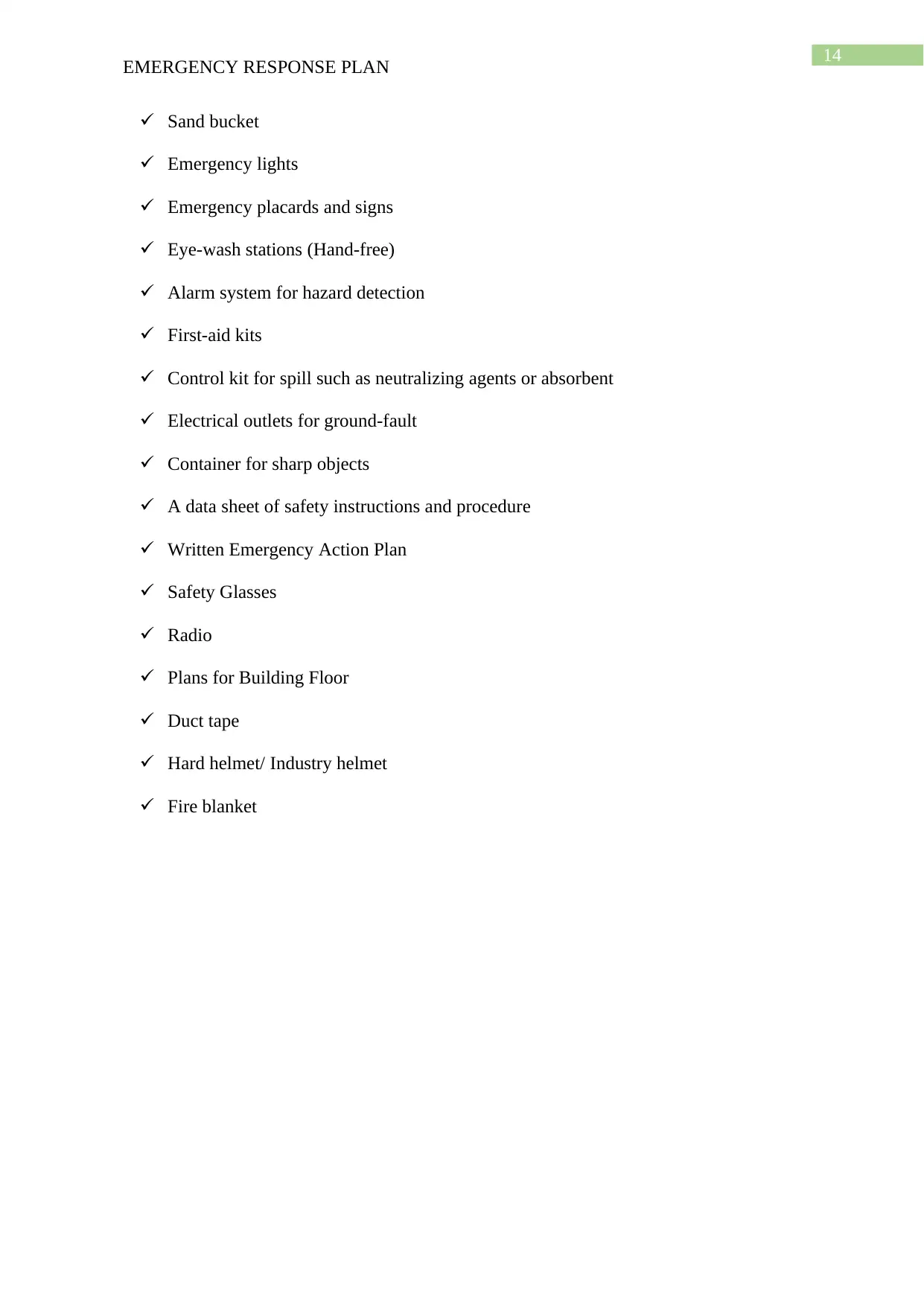
14
EMERGENCY RESPONSE PLAN
Sand bucket
Emergency lights
Emergency placards and signs
Eye-wash stations (Hand-free)
Alarm system for hazard detection
First-aid kits
Control kit for spill such as neutralizing agents or absorbent
Electrical outlets for ground-fault
Container for sharp objects
A data sheet of safety instructions and procedure
Written Emergency Action Plan
Safety Glasses
Radio
Plans for Building Floor
Duct tape
Hard helmet/ Industry helmet
Fire blanket
EMERGENCY RESPONSE PLAN
Sand bucket
Emergency lights
Emergency placards and signs
Eye-wash stations (Hand-free)
Alarm system for hazard detection
First-aid kits
Control kit for spill such as neutralizing agents or absorbent
Electrical outlets for ground-fault
Container for sharp objects
A data sheet of safety instructions and procedure
Written Emergency Action Plan
Safety Glasses
Radio
Plans for Building Floor
Duct tape
Hard helmet/ Industry helmet
Fire blanket
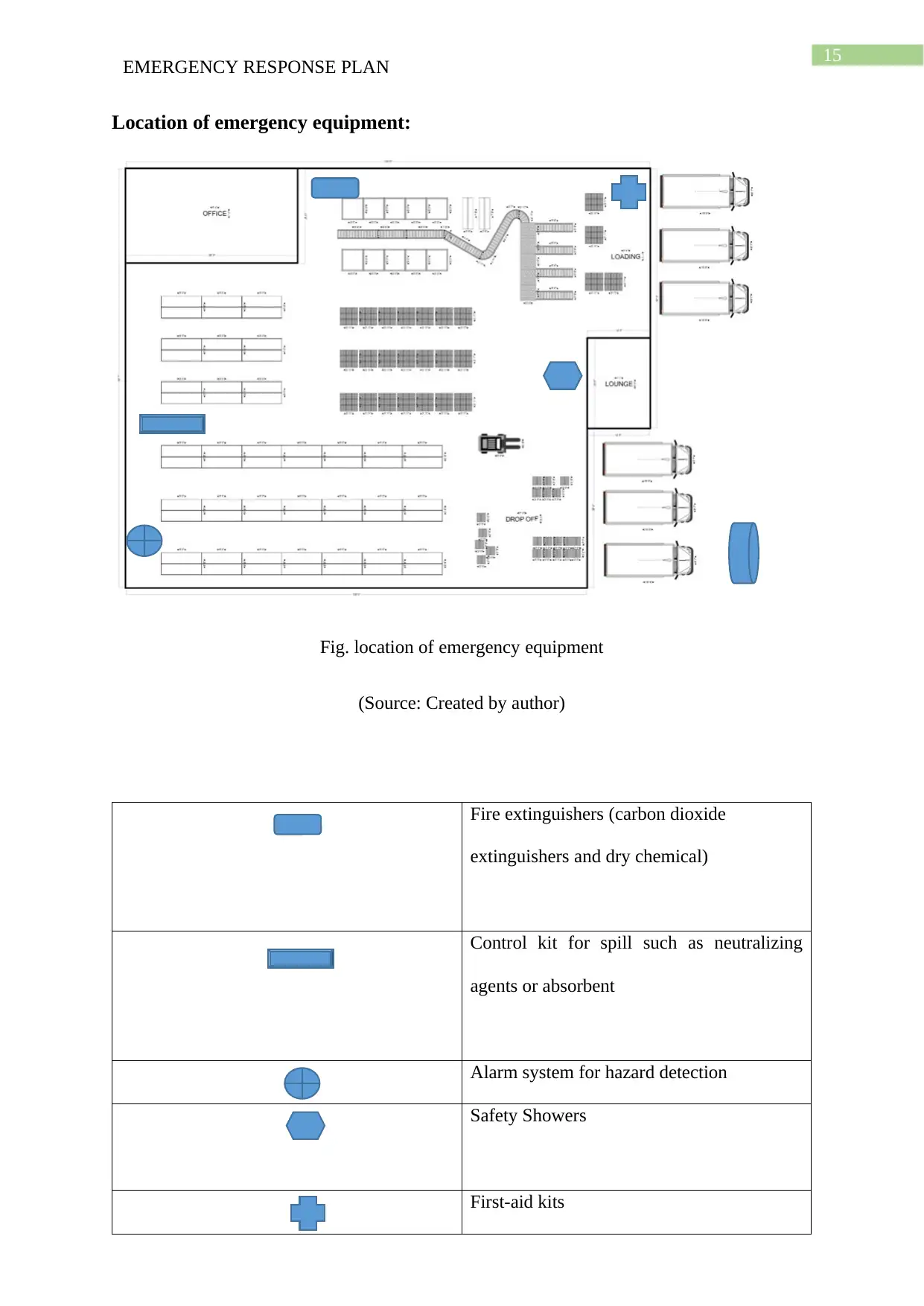
15
EMERGENCY RESPONSE PLAN
Location of emergency equipment:
Fig. location of emergency equipment
(Source: Created by author)
Fire extinguishers (carbon dioxide
extinguishers and dry chemical)
Control kit for spill such as neutralizing
agents or absorbent
Alarm system for hazard detection
Safety Showers
First-aid kits
EMERGENCY RESPONSE PLAN
Location of emergency equipment:
Fig. location of emergency equipment
(Source: Created by author)
Fire extinguishers (carbon dioxide
extinguishers and dry chemical)
Control kit for spill such as neutralizing
agents or absorbent
Alarm system for hazard detection
Safety Showers
First-aid kits
Secure Best Marks with AI Grader
Need help grading? Try our AI Grader for instant feedback on your assignments.
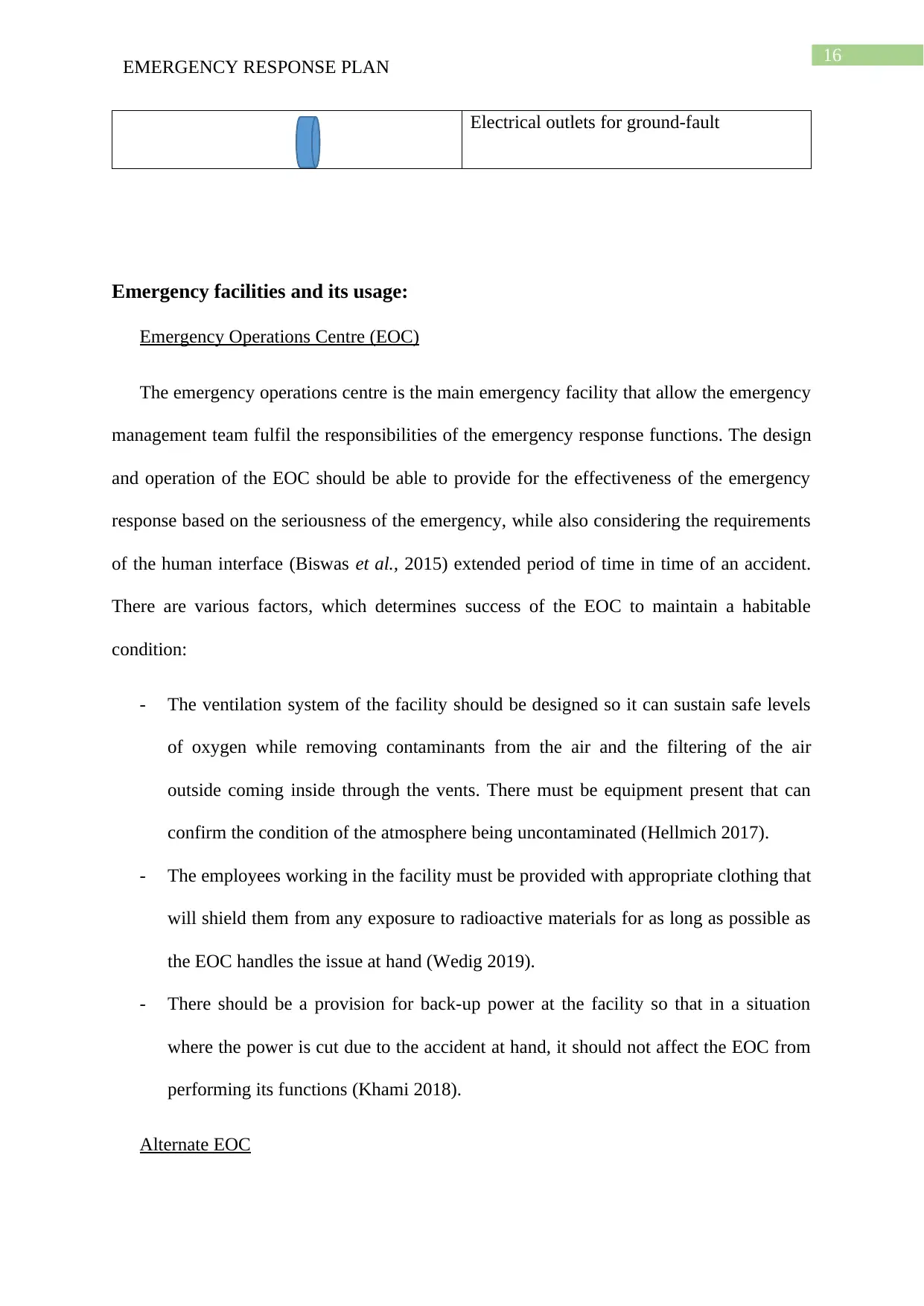
16
EMERGENCY RESPONSE PLAN
Electrical outlets for ground-fault
Emergency facilities and its usage:
Emergency Operations Centre (EOC)
The emergency operations centre is the main emergency facility that allow the emergency
management team fulfil the responsibilities of the emergency response functions. The design
and operation of the EOC should be able to provide for the effectiveness of the emergency
response based on the seriousness of the emergency, while also considering the requirements
of the human interface (Biswas et al., 2015) extended period of time in time of an accident.
There are various factors, which determines success of the EOC to maintain a habitable
condition:
- The ventilation system of the facility should be designed so it can sustain safe levels
of oxygen while removing contaminants from the air and the filtering of the air
outside coming inside through the vents. There must be equipment present that can
confirm the condition of the atmosphere being uncontaminated (Hellmich 2017).
- The employees working in the facility must be provided with appropriate clothing that
will shield them from any exposure to radioactive materials for as long as possible as
the EOC handles the issue at hand (Wedig 2019).
- There should be a provision for back-up power at the facility so that in a situation
where the power is cut due to the accident at hand, it should not affect the EOC from
performing its functions (Khami 2018).
Alternate EOC
EMERGENCY RESPONSE PLAN
Electrical outlets for ground-fault
Emergency facilities and its usage:
Emergency Operations Centre (EOC)
The emergency operations centre is the main emergency facility that allow the emergency
management team fulfil the responsibilities of the emergency response functions. The design
and operation of the EOC should be able to provide for the effectiveness of the emergency
response based on the seriousness of the emergency, while also considering the requirements
of the human interface (Biswas et al., 2015) extended period of time in time of an accident.
There are various factors, which determines success of the EOC to maintain a habitable
condition:
- The ventilation system of the facility should be designed so it can sustain safe levels
of oxygen while removing contaminants from the air and the filtering of the air
outside coming inside through the vents. There must be equipment present that can
confirm the condition of the atmosphere being uncontaminated (Hellmich 2017).
- The employees working in the facility must be provided with appropriate clothing that
will shield them from any exposure to radioactive materials for as long as possible as
the EOC handles the issue at hand (Wedig 2019).
- There should be a provision for back-up power at the facility so that in a situation
where the power is cut due to the accident at hand, it should not affect the EOC from
performing its functions (Khami 2018).
Alternate EOC
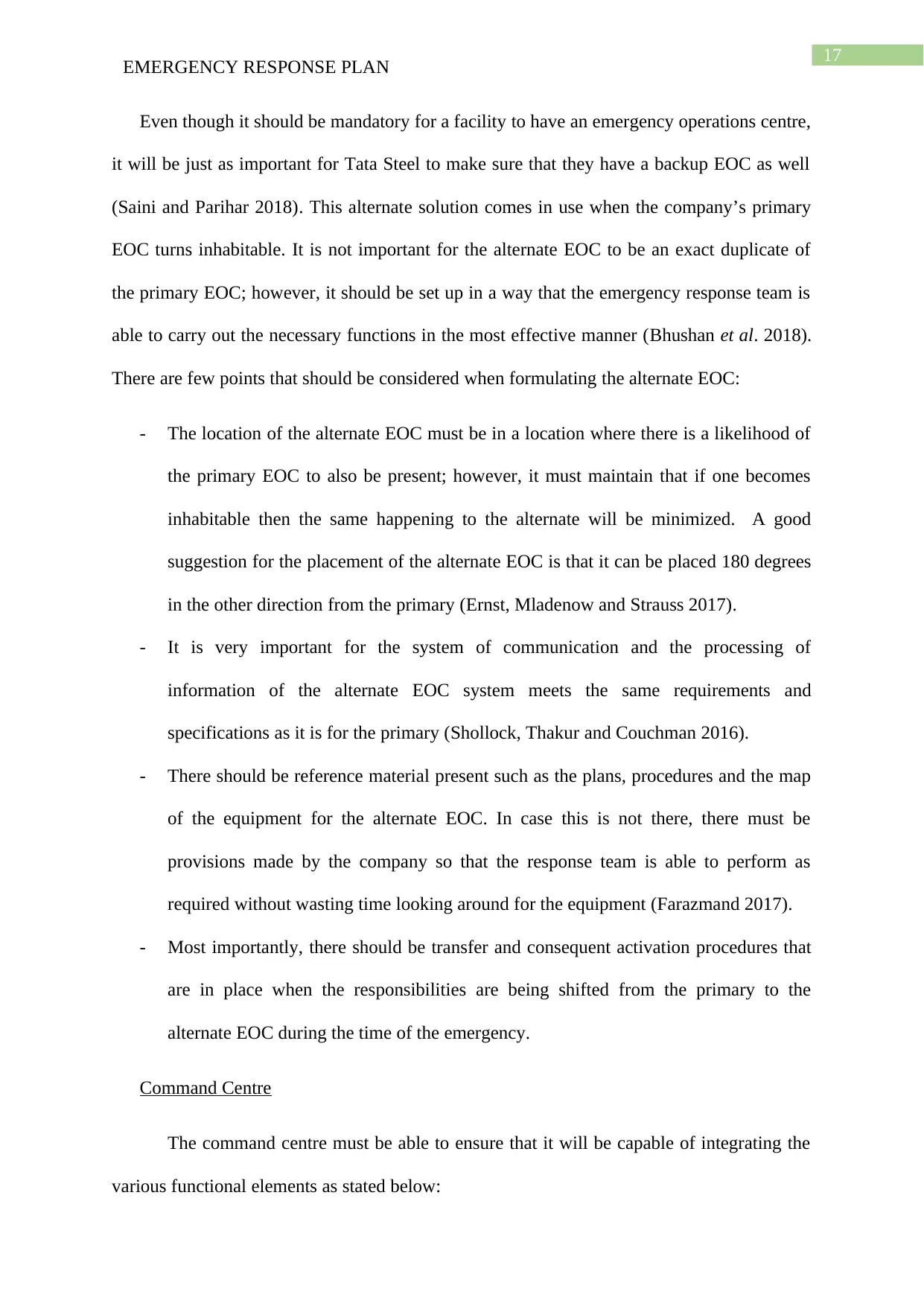
17
EMERGENCY RESPONSE PLAN
Even though it should be mandatory for a facility to have an emergency operations centre,
it will be just as important for Tata Steel to make sure that they have a backup EOC as well
(Saini and Parihar 2018). This alternate solution comes in use when the company’s primary
EOC turns inhabitable. It is not important for the alternate EOC to be an exact duplicate of
the primary EOC; however, it should be set up in a way that the emergency response team is
able to carry out the necessary functions in the most effective manner (Bhushan et al. 2018).
There are few points that should be considered when formulating the alternate EOC:
- The location of the alternate EOC must be in a location where there is a likelihood of
the primary EOC to also be present; however, it must maintain that if one becomes
inhabitable then the same happening to the alternate will be minimized. A good
suggestion for the placement of the alternate EOC is that it can be placed 180 degrees
in the other direction from the primary (Ernst, Mladenow and Strauss 2017).
- It is very important for the system of communication and the processing of
information of the alternate EOC system meets the same requirements and
specifications as it is for the primary (Shollock, Thakur and Couchman 2016).
- There should be reference material present such as the plans, procedures and the map
of the equipment for the alternate EOC. In case this is not there, there must be
provisions made by the company so that the response team is able to perform as
required without wasting time looking around for the equipment (Farazmand 2017).
- Most importantly, there should be transfer and consequent activation procedures that
are in place when the responsibilities are being shifted from the primary to the
alternate EOC during the time of the emergency.
Command Centre
The command centre must be able to ensure that it will be capable of integrating the
various functional elements as stated below:
EMERGENCY RESPONSE PLAN
Even though it should be mandatory for a facility to have an emergency operations centre,
it will be just as important for Tata Steel to make sure that they have a backup EOC as well
(Saini and Parihar 2018). This alternate solution comes in use when the company’s primary
EOC turns inhabitable. It is not important for the alternate EOC to be an exact duplicate of
the primary EOC; however, it should be set up in a way that the emergency response team is
able to carry out the necessary functions in the most effective manner (Bhushan et al. 2018).
There are few points that should be considered when formulating the alternate EOC:
- The location of the alternate EOC must be in a location where there is a likelihood of
the primary EOC to also be present; however, it must maintain that if one becomes
inhabitable then the same happening to the alternate will be minimized. A good
suggestion for the placement of the alternate EOC is that it can be placed 180 degrees
in the other direction from the primary (Ernst, Mladenow and Strauss 2017).
- It is very important for the system of communication and the processing of
information of the alternate EOC system meets the same requirements and
specifications as it is for the primary (Shollock, Thakur and Couchman 2016).
- There should be reference material present such as the plans, procedures and the map
of the equipment for the alternate EOC. In case this is not there, there must be
provisions made by the company so that the response team is able to perform as
required without wasting time looking around for the equipment (Farazmand 2017).
- Most importantly, there should be transfer and consequent activation procedures that
are in place when the responsibilities are being shifted from the primary to the
alternate EOC during the time of the emergency.
Command Centre
The command centre must be able to ensure that it will be capable of integrating the
various functional elements as stated below:
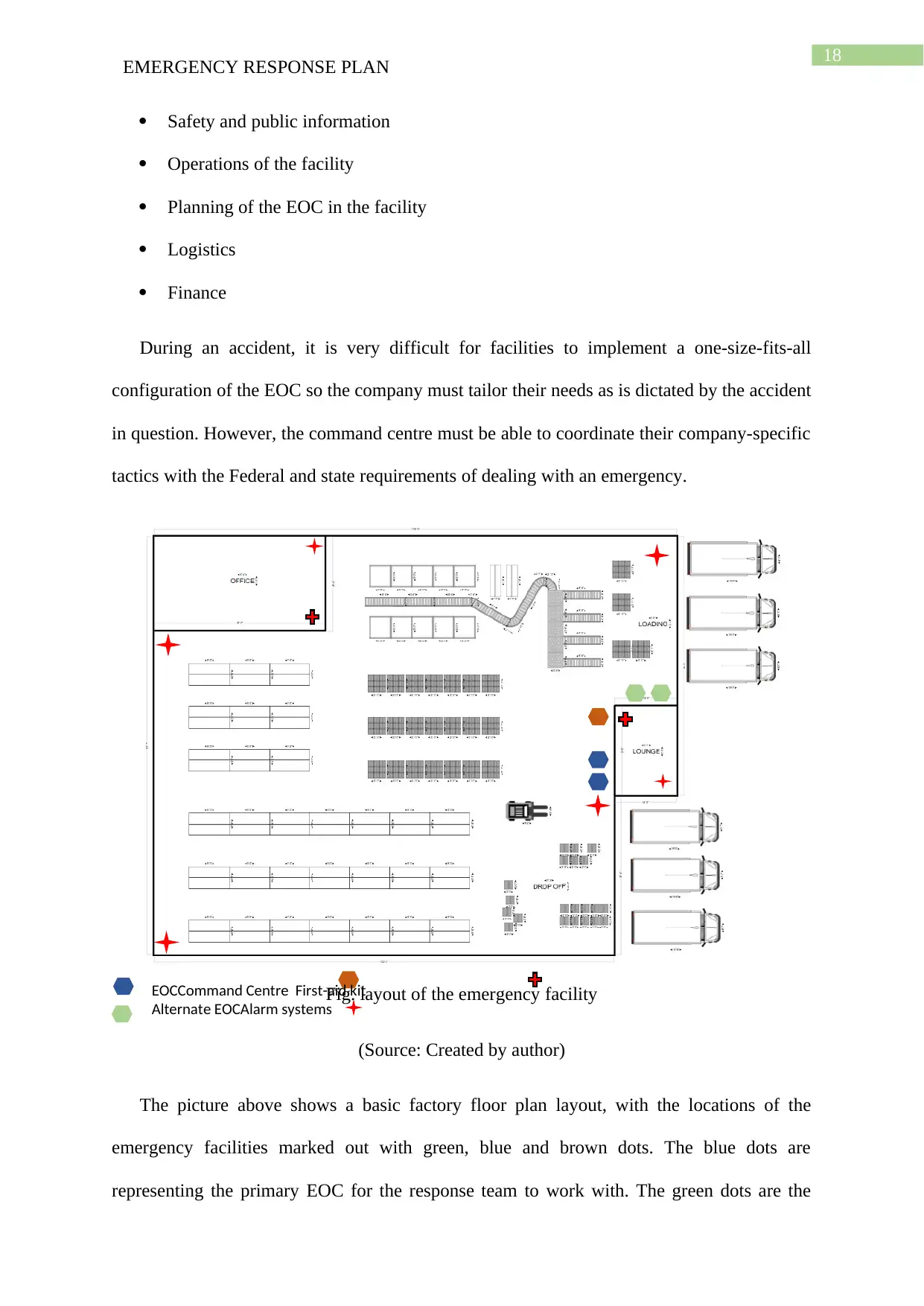
18
EMERGENCY RESPONSE PLAN
Safety and public information
Operations of the facility
Planning of the EOC in the facility
Logistics
Finance
During an accident, it is very difficult for facilities to implement a one-size-fits-all
configuration of the EOC so the company must tailor their needs as is dictated by the accident
in question. However, the command centre must be able to coordinate their company-specific
tactics with the Federal and state requirements of dealing with an emergency.
Fig. layout of the emergency facility
(Source: Created by author)
The picture above shows a basic factory floor plan layout, with the locations of the
emergency facilities marked out with green, blue and brown dots. The blue dots are
representing the primary EOC for the response team to work with. The green dots are the
EOCCommand Centre First-aid kit
Alternate EOCAlarm systems
EMERGENCY RESPONSE PLAN
Safety and public information
Operations of the facility
Planning of the EOC in the facility
Logistics
Finance
During an accident, it is very difficult for facilities to implement a one-size-fits-all
configuration of the EOC so the company must tailor their needs as is dictated by the accident
in question. However, the command centre must be able to coordinate their company-specific
tactics with the Federal and state requirements of dealing with an emergency.
Fig. layout of the emergency facility
(Source: Created by author)
The picture above shows a basic factory floor plan layout, with the locations of the
emergency facilities marked out with green, blue and brown dots. The blue dots are
representing the primary EOC for the response team to work with. The green dots are the
EOCCommand Centre First-aid kit
Alternate EOCAlarm systems
Paraphrase This Document
Need a fresh take? Get an instant paraphrase of this document with our AI Paraphraser
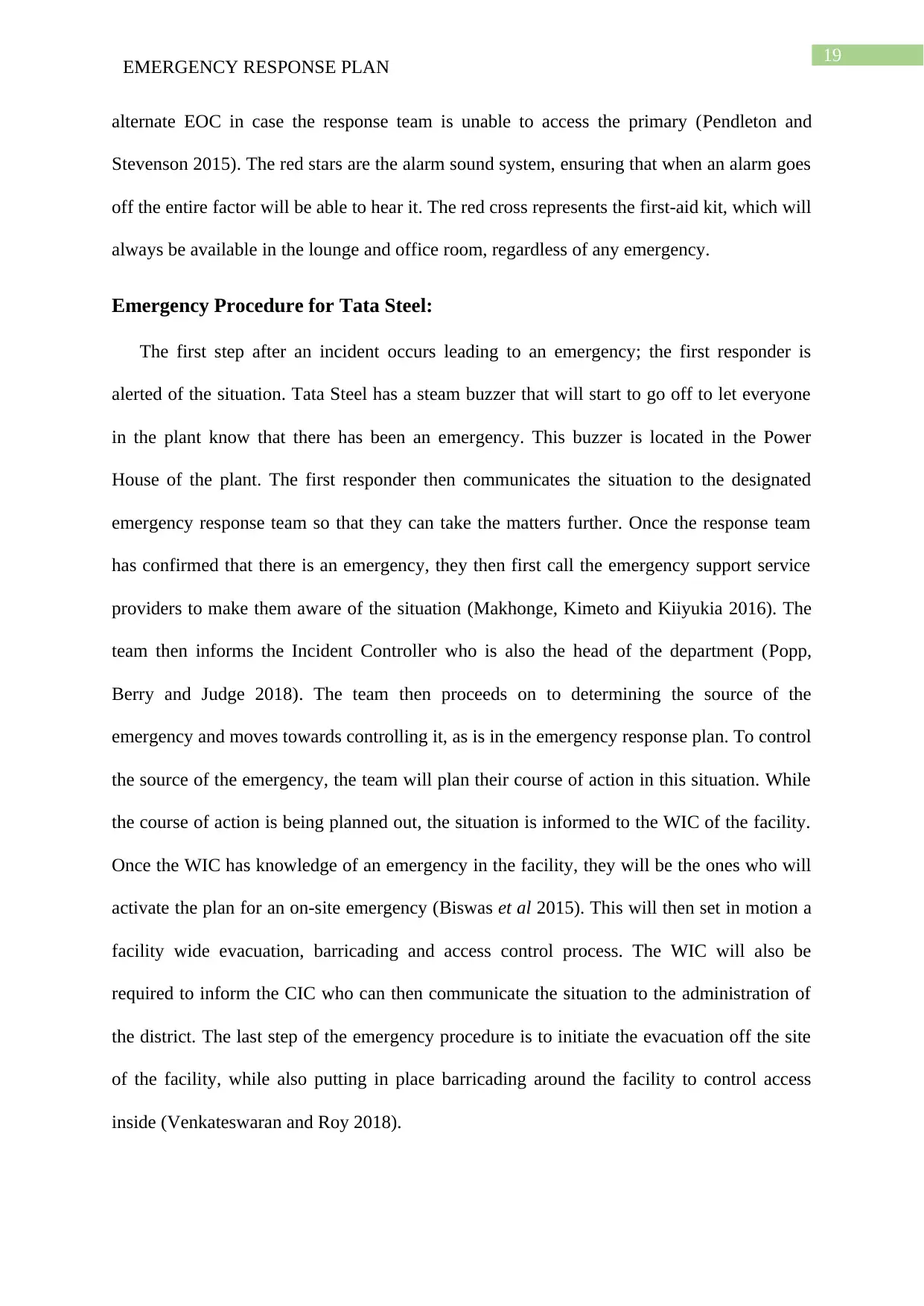
19
EMERGENCY RESPONSE PLAN
alternate EOC in case the response team is unable to access the primary (Pendleton and
Stevenson 2015). The red stars are the alarm sound system, ensuring that when an alarm goes
off the entire factor will be able to hear it. The red cross represents the first-aid kit, which will
always be available in the lounge and office room, regardless of any emergency.
Emergency Procedure for Tata Steel:
The first step after an incident occurs leading to an emergency; the first responder is
alerted of the situation. Tata Steel has a steam buzzer that will start to go off to let everyone
in the plant know that there has been an emergency. This buzzer is located in the Power
House of the plant. The first responder then communicates the situation to the designated
emergency response team so that they can take the matters further. Once the response team
has confirmed that there is an emergency, they then first call the emergency support service
providers to make them aware of the situation (Makhonge, Kimeto and Kiiyukia 2016). The
team then informs the Incident Controller who is also the head of the department (Popp,
Berry and Judge 2018). The team then proceeds on to determining the source of the
emergency and moves towards controlling it, as is in the emergency response plan. To control
the source of the emergency, the team will plan their course of action in this situation. While
the course of action is being planned out, the situation is informed to the WIC of the facility.
Once the WIC has knowledge of an emergency in the facility, they will be the ones who will
activate the plan for an on-site emergency (Biswas et al 2015). This will then set in motion a
facility wide evacuation, barricading and access control process. The WIC will also be
required to inform the CIC who can then communicate the situation to the administration of
the district. The last step of the emergency procedure is to initiate the evacuation off the site
of the facility, while also putting in place barricading around the facility to control access
inside (Venkateswaran and Roy 2018).
EMERGENCY RESPONSE PLAN
alternate EOC in case the response team is unable to access the primary (Pendleton and
Stevenson 2015). The red stars are the alarm sound system, ensuring that when an alarm goes
off the entire factor will be able to hear it. The red cross represents the first-aid kit, which will
always be available in the lounge and office room, regardless of any emergency.
Emergency Procedure for Tata Steel:
The first step after an incident occurs leading to an emergency; the first responder is
alerted of the situation. Tata Steel has a steam buzzer that will start to go off to let everyone
in the plant know that there has been an emergency. This buzzer is located in the Power
House of the plant. The first responder then communicates the situation to the designated
emergency response team so that they can take the matters further. Once the response team
has confirmed that there is an emergency, they then first call the emergency support service
providers to make them aware of the situation (Makhonge, Kimeto and Kiiyukia 2016). The
team then informs the Incident Controller who is also the head of the department (Popp,
Berry and Judge 2018). The team then proceeds on to determining the source of the
emergency and moves towards controlling it, as is in the emergency response plan. To control
the source of the emergency, the team will plan their course of action in this situation. While
the course of action is being planned out, the situation is informed to the WIC of the facility.
Once the WIC has knowledge of an emergency in the facility, they will be the ones who will
activate the plan for an on-site emergency (Biswas et al 2015). This will then set in motion a
facility wide evacuation, barricading and access control process. The WIC will also be
required to inform the CIC who can then communicate the situation to the administration of
the district. The last step of the emergency procedure is to initiate the evacuation off the site
of the facility, while also putting in place barricading around the facility to control access
inside (Venkateswaran and Roy 2018).
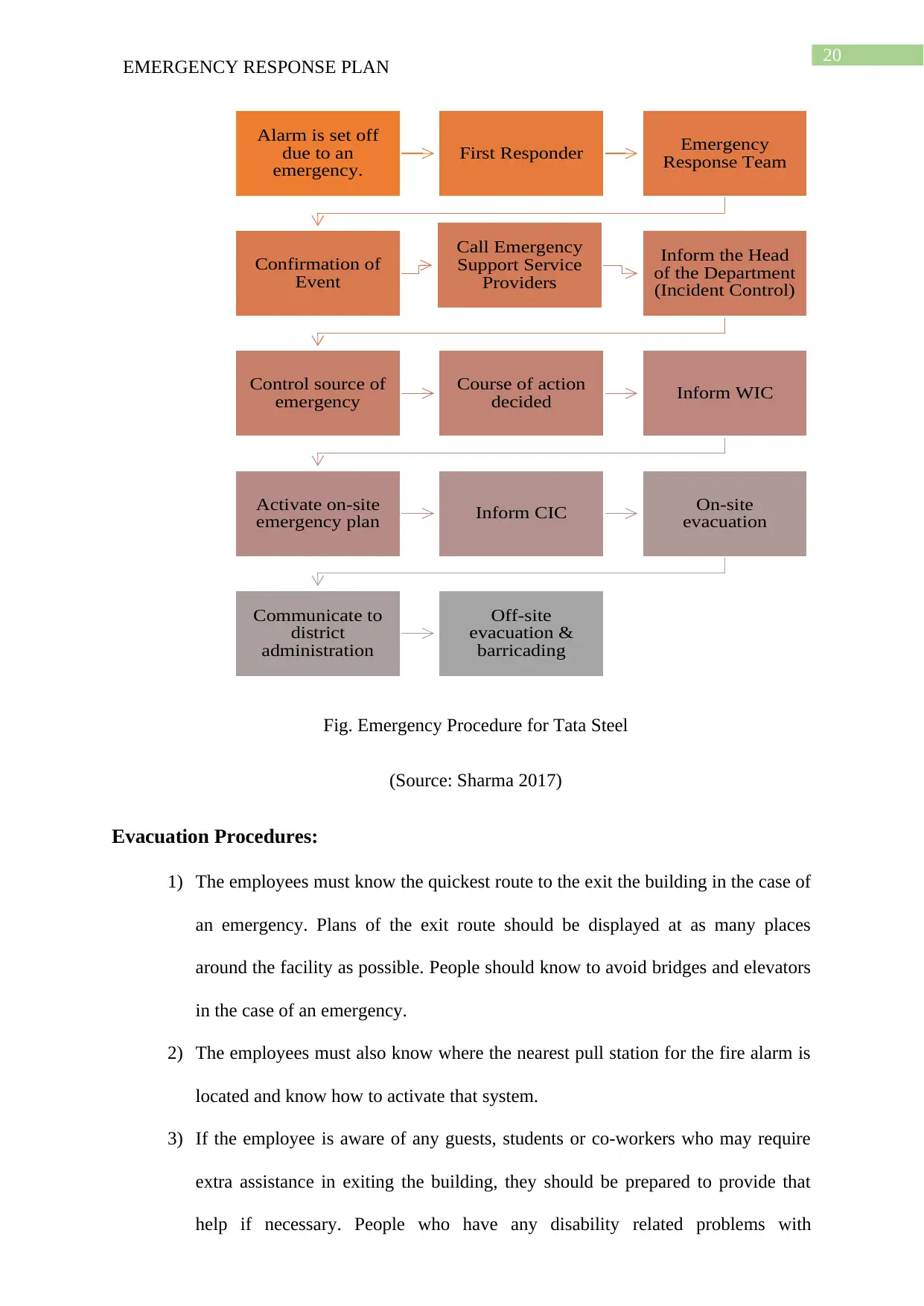
20
EMERGENCY RESPONSE PLAN
Fig. Emergency Procedure for Tata Steel
(Source: Sharma 2017)
Evacuation Procedures:
1) The employees must know the quickest route to the exit the building in the case of
an emergency. Plans of the exit route should be displayed at as many places
around the facility as possible. People should know to avoid bridges and elevators
in the case of an emergency.
2) The employees must also know where the nearest pull station for the fire alarm is
located and know how to activate that system.
3) If the employee is aware of any guests, students or co-workers who may require
extra assistance in exiting the building, they should be prepared to provide that
help if necessary. People who have any disability related problems with
Alarm is set off
due to an
emergency.
First Responder Emergency
Response Team
Confirmation of
Event
Call Emergency
Support Service
Providers
Inform the Head
of the Department
(Incident Control)
Control source of
emergency
Course of action
decided Inform WIC
Activate on-site
emergency plan Inform CIC On-site
evacuation
Communicate to
district
administration
Off-site
evacuation &
barricading
EMERGENCY RESPONSE PLAN
Fig. Emergency Procedure for Tata Steel
(Source: Sharma 2017)
Evacuation Procedures:
1) The employees must know the quickest route to the exit the building in the case of
an emergency. Plans of the exit route should be displayed at as many places
around the facility as possible. People should know to avoid bridges and elevators
in the case of an emergency.
2) The employees must also know where the nearest pull station for the fire alarm is
located and know how to activate that system.
3) If the employee is aware of any guests, students or co-workers who may require
extra assistance in exiting the building, they should be prepared to provide that
help if necessary. People who have any disability related problems with
Alarm is set off
due to an
emergency.
First Responder Emergency
Response Team
Confirmation of
Event
Call Emergency
Support Service
Providers
Inform the Head
of the Department
(Incident Control)
Control source of
emergency
Course of action
decided Inform WIC
Activate on-site
emergency plan Inform CIC On-site
evacuation
Communicate to
district
administration
Off-site
evacuation &
barricading
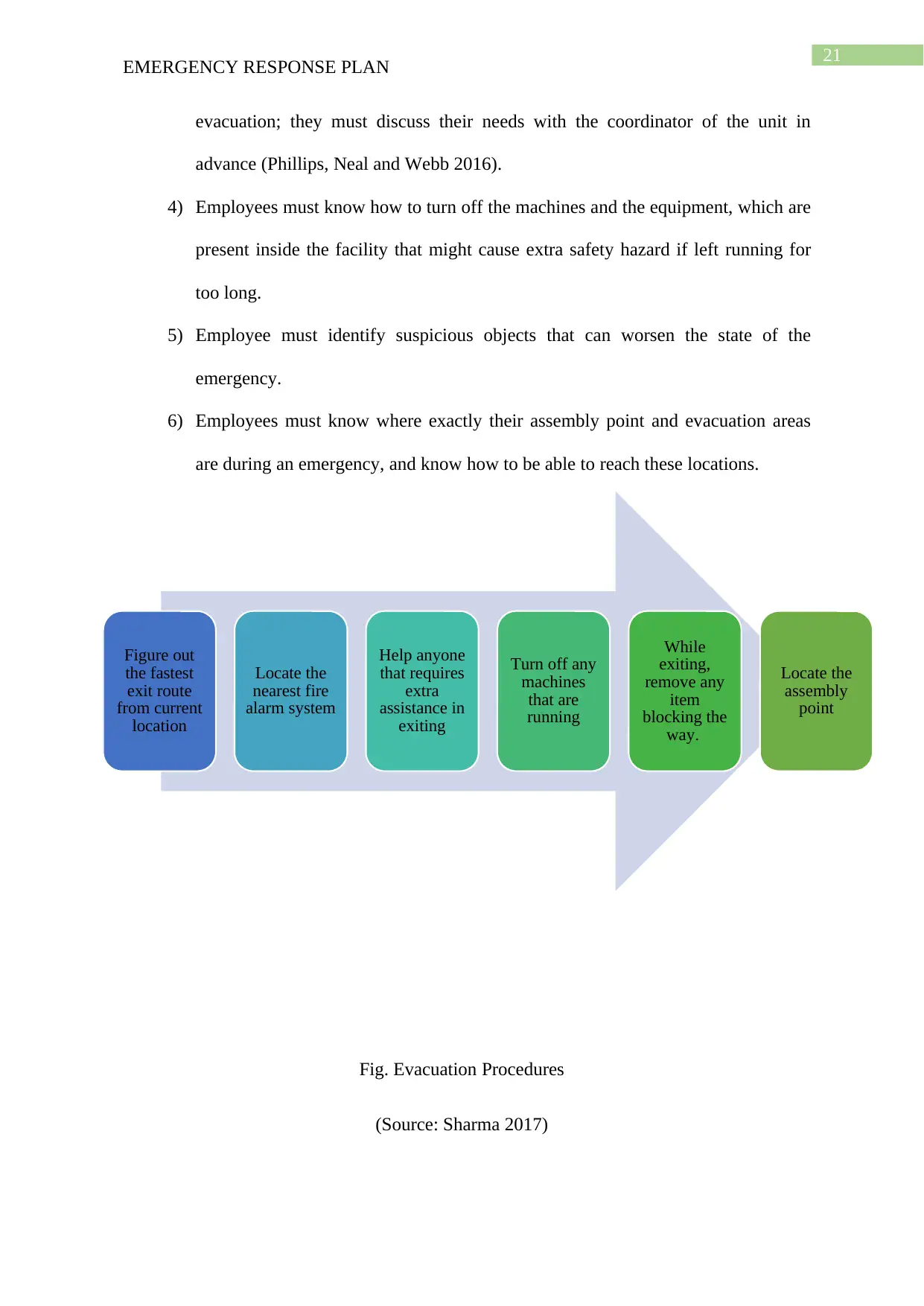
21
EMERGENCY RESPONSE PLAN
evacuation; they must discuss their needs with the coordinator of the unit in
advance (Phillips, Neal and Webb 2016).
4) Employees must know how to turn off the machines and the equipment, which are
present inside the facility that might cause extra safety hazard if left running for
too long.
5) Employee must identify suspicious objects that can worsen the state of the
emergency.
6) Employees must know where exactly their assembly point and evacuation areas
are during an emergency, and know how to be able to reach these locations.
Fig. Evacuation Procedures
(Source: Sharma 2017)
Figure out
the fastest
exit route
from current
location
Locate the
nearest fire
alarm system
Help anyone
that requires
extra
assistance in
exiting
Turn off any
machines
that are
running
While
exiting,
remove any
item
blocking the
way.
Locate the
assembly
point
EMERGENCY RESPONSE PLAN
evacuation; they must discuss their needs with the coordinator of the unit in
advance (Phillips, Neal and Webb 2016).
4) Employees must know how to turn off the machines and the equipment, which are
present inside the facility that might cause extra safety hazard if left running for
too long.
5) Employee must identify suspicious objects that can worsen the state of the
emergency.
6) Employees must know where exactly their assembly point and evacuation areas
are during an emergency, and know how to be able to reach these locations.
Fig. Evacuation Procedures
(Source: Sharma 2017)
Figure out
the fastest
exit route
from current
location
Locate the
nearest fire
alarm system
Help anyone
that requires
extra
assistance in
exiting
Turn off any
machines
that are
running
While
exiting,
remove any
item
blocking the
way.
Locate the
assembly
point
Secure Best Marks with AI Grader
Need help grading? Try our AI Grader for instant feedback on your assignments.
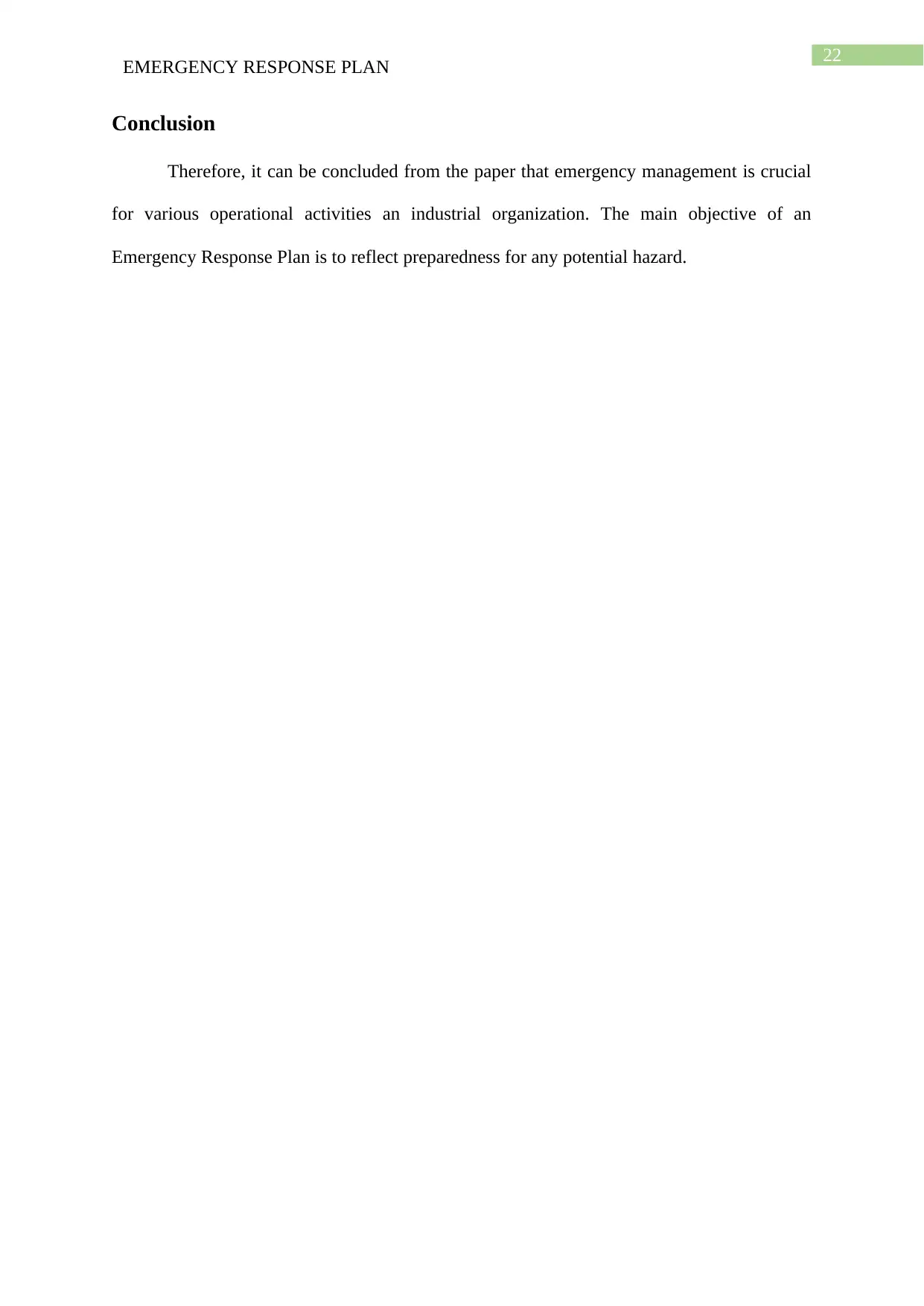
22
EMERGENCY RESPONSE PLAN
Conclusion
Therefore, it can be concluded from the paper that emergency management is crucial
for various operational activities an industrial organization. The main objective of an
Emergency Response Plan is to reflect preparedness for any potential hazard.
EMERGENCY RESPONSE PLAN
Conclusion
Therefore, it can be concluded from the paper that emergency management is crucial
for various operational activities an industrial organization. The main objective of an
Emergency Response Plan is to reflect preparedness for any potential hazard.
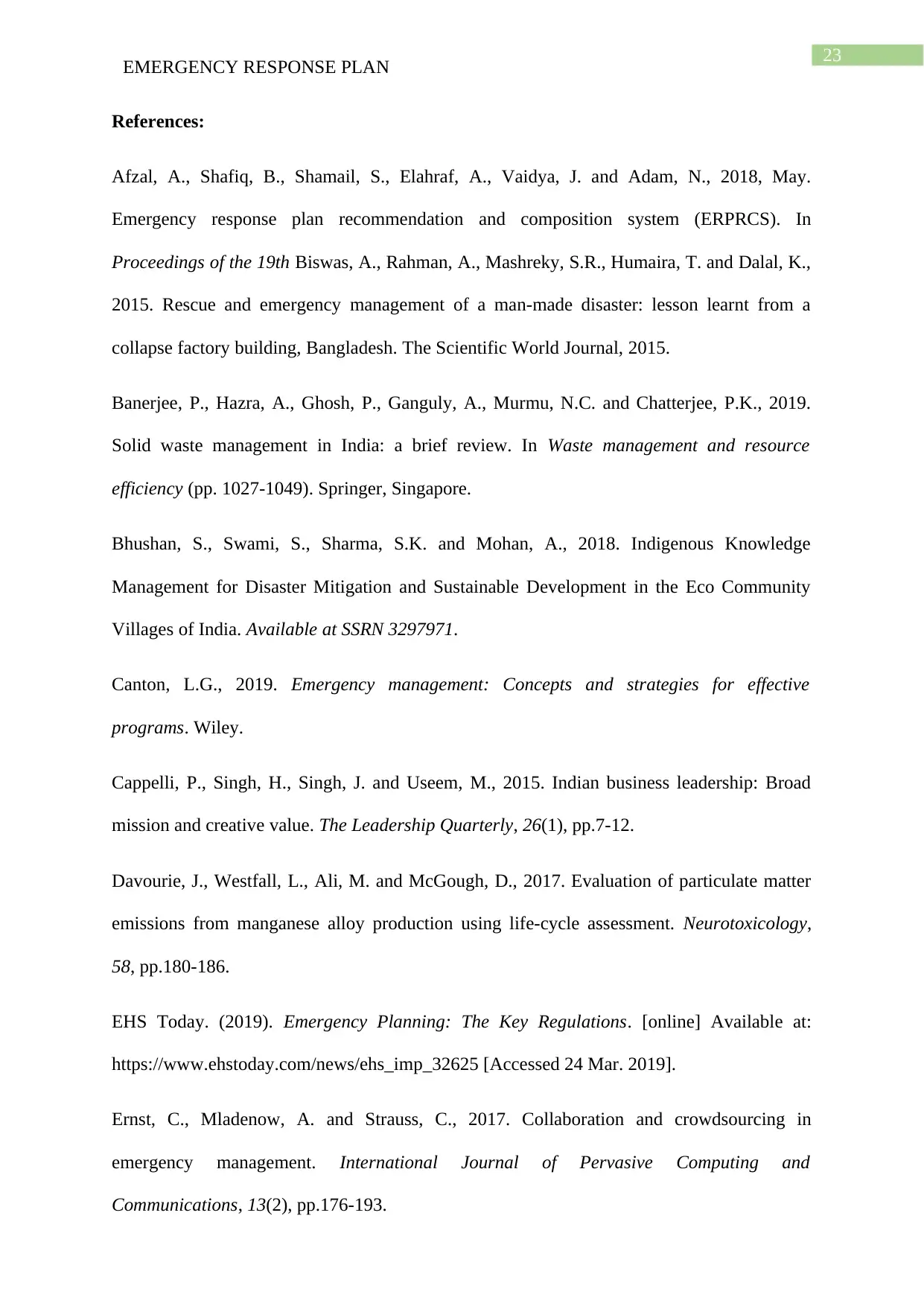
23
EMERGENCY RESPONSE PLAN
References:
Afzal, A., Shafiq, B., Shamail, S., Elahraf, A., Vaidya, J. and Adam, N., 2018, May.
Emergency response plan recommendation and composition system (ERPRCS). In
Proceedings of the 19th Biswas, A., Rahman, A., Mashreky, S.R., Humaira, T. and Dalal, K.,
2015. Rescue and emergency management of a man-made disaster: lesson learnt from a
collapse factory building, Bangladesh. The Scientific World Journal, 2015.
Banerjee, P., Hazra, A., Ghosh, P., Ganguly, A., Murmu, N.C. and Chatterjee, P.K., 2019.
Solid waste management in India: a brief review. In Waste management and resource
efficiency (pp. 1027-1049). Springer, Singapore.
Bhushan, S., Swami, S., Sharma, S.K. and Mohan, A., 2018. Indigenous Knowledge
Management for Disaster Mitigation and Sustainable Development in the Eco Community
Villages of India. Available at SSRN 3297971.
Canton, L.G., 2019. Emergency management: Concepts and strategies for effective
programs. Wiley.
Cappelli, P., Singh, H., Singh, J. and Useem, M., 2015. Indian business leadership: Broad
mission and creative value. The Leadership Quarterly, 26(1), pp.7-12.
Davourie, J., Westfall, L., Ali, M. and McGough, D., 2017. Evaluation of particulate matter
emissions from manganese alloy production using life-cycle assessment. Neurotoxicology,
58, pp.180-186.
EHS Today. (2019). Emergency Planning: The Key Regulations. [online] Available at:
https://www.ehstoday.com/news/ehs_imp_32625 [Accessed 24 Mar. 2019].
Ernst, C., Mladenow, A. and Strauss, C., 2017. Collaboration and crowdsourcing in
emergency management. International Journal of Pervasive Computing and
Communications, 13(2), pp.176-193.
EMERGENCY RESPONSE PLAN
References:
Afzal, A., Shafiq, B., Shamail, S., Elahraf, A., Vaidya, J. and Adam, N., 2018, May.
Emergency response plan recommendation and composition system (ERPRCS). In
Proceedings of the 19th Biswas, A., Rahman, A., Mashreky, S.R., Humaira, T. and Dalal, K.,
2015. Rescue and emergency management of a man-made disaster: lesson learnt from a
collapse factory building, Bangladesh. The Scientific World Journal, 2015.
Banerjee, P., Hazra, A., Ghosh, P., Ganguly, A., Murmu, N.C. and Chatterjee, P.K., 2019.
Solid waste management in India: a brief review. In Waste management and resource
efficiency (pp. 1027-1049). Springer, Singapore.
Bhushan, S., Swami, S., Sharma, S.K. and Mohan, A., 2018. Indigenous Knowledge
Management for Disaster Mitigation and Sustainable Development in the Eco Community
Villages of India. Available at SSRN 3297971.
Canton, L.G., 2019. Emergency management: Concepts and strategies for effective
programs. Wiley.
Cappelli, P., Singh, H., Singh, J. and Useem, M., 2015. Indian business leadership: Broad
mission and creative value. The Leadership Quarterly, 26(1), pp.7-12.
Davourie, J., Westfall, L., Ali, M. and McGough, D., 2017. Evaluation of particulate matter
emissions from manganese alloy production using life-cycle assessment. Neurotoxicology,
58, pp.180-186.
EHS Today. (2019). Emergency Planning: The Key Regulations. [online] Available at:
https://www.ehstoday.com/news/ehs_imp_32625 [Accessed 24 Mar. 2019].
Ernst, C., Mladenow, A. and Strauss, C., 2017. Collaboration and crowdsourcing in
emergency management. International Journal of Pervasive Computing and
Communications, 13(2), pp.176-193.
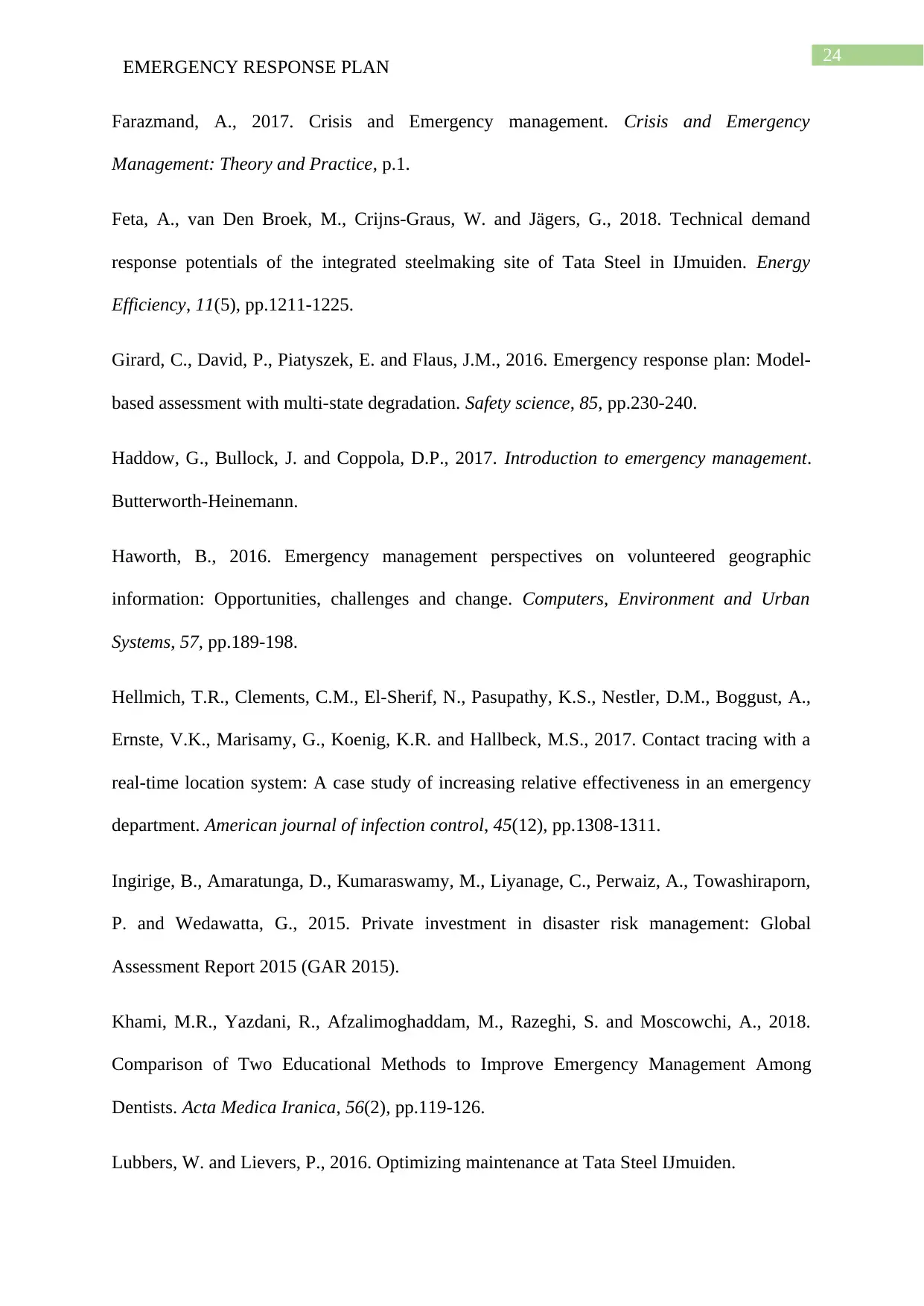
24
EMERGENCY RESPONSE PLAN
Farazmand, A., 2017. Crisis and Emergency management. Crisis and Emergency
Management: Theory and Practice, p.1.
Feta, A., van Den Broek, M., Crijns-Graus, W. and Jägers, G., 2018. Technical demand
response potentials of the integrated steelmaking site of Tata Steel in IJmuiden. Energy
Efficiency, 11(5), pp.1211-1225.
Girard, C., David, P., Piatyszek, E. and Flaus, J.M., 2016. Emergency response plan: Model-
based assessment with multi-state degradation. Safety science, 85, pp.230-240.
Haddow, G., Bullock, J. and Coppola, D.P., 2017. Introduction to emergency management.
Butterworth-Heinemann.
Haworth, B., 2016. Emergency management perspectives on volunteered geographic
information: Opportunities, challenges and change. Computers, Environment and Urban
Systems, 57, pp.189-198.
Hellmich, T.R., Clements, C.M., El-Sherif, N., Pasupathy, K.S., Nestler, D.M., Boggust, A.,
Ernste, V.K., Marisamy, G., Koenig, K.R. and Hallbeck, M.S., 2017. Contact tracing with a
real-time location system: A case study of increasing relative effectiveness in an emergency
department. American journal of infection control, 45(12), pp.1308-1311.
Ingirige, B., Amaratunga, D., Kumaraswamy, M., Liyanage, C., Perwaiz, A., Towashiraporn,
P. and Wedawatta, G., 2015. Private investment in disaster risk management: Global
Assessment Report 2015 (GAR 2015).
Khami, M.R., Yazdani, R., Afzalimoghaddam, M., Razeghi, S. and Moscowchi, A., 2018.
Comparison of Two Educational Methods to Improve Emergency Management Among
Dentists. Acta Medica Iranica, 56(2), pp.119-126.
Lubbers, W. and Lievers, P., 2016. Optimizing maintenance at Tata Steel IJmuiden.
EMERGENCY RESPONSE PLAN
Farazmand, A., 2017. Crisis and Emergency management. Crisis and Emergency
Management: Theory and Practice, p.1.
Feta, A., van Den Broek, M., Crijns-Graus, W. and Jägers, G., 2018. Technical demand
response potentials of the integrated steelmaking site of Tata Steel in IJmuiden. Energy
Efficiency, 11(5), pp.1211-1225.
Girard, C., David, P., Piatyszek, E. and Flaus, J.M., 2016. Emergency response plan: Model-
based assessment with multi-state degradation. Safety science, 85, pp.230-240.
Haddow, G., Bullock, J. and Coppola, D.P., 2017. Introduction to emergency management.
Butterworth-Heinemann.
Haworth, B., 2016. Emergency management perspectives on volunteered geographic
information: Opportunities, challenges and change. Computers, Environment and Urban
Systems, 57, pp.189-198.
Hellmich, T.R., Clements, C.M., El-Sherif, N., Pasupathy, K.S., Nestler, D.M., Boggust, A.,
Ernste, V.K., Marisamy, G., Koenig, K.R. and Hallbeck, M.S., 2017. Contact tracing with a
real-time location system: A case study of increasing relative effectiveness in an emergency
department. American journal of infection control, 45(12), pp.1308-1311.
Ingirige, B., Amaratunga, D., Kumaraswamy, M., Liyanage, C., Perwaiz, A., Towashiraporn,
P. and Wedawatta, G., 2015. Private investment in disaster risk management: Global
Assessment Report 2015 (GAR 2015).
Khami, M.R., Yazdani, R., Afzalimoghaddam, M., Razeghi, S. and Moscowchi, A., 2018.
Comparison of Two Educational Methods to Improve Emergency Management Among
Dentists. Acta Medica Iranica, 56(2), pp.119-126.
Lubbers, W. and Lievers, P., 2016. Optimizing maintenance at Tata Steel IJmuiden.
Paraphrase This Document
Need a fresh take? Get an instant paraphrase of this document with our AI Paraphraser
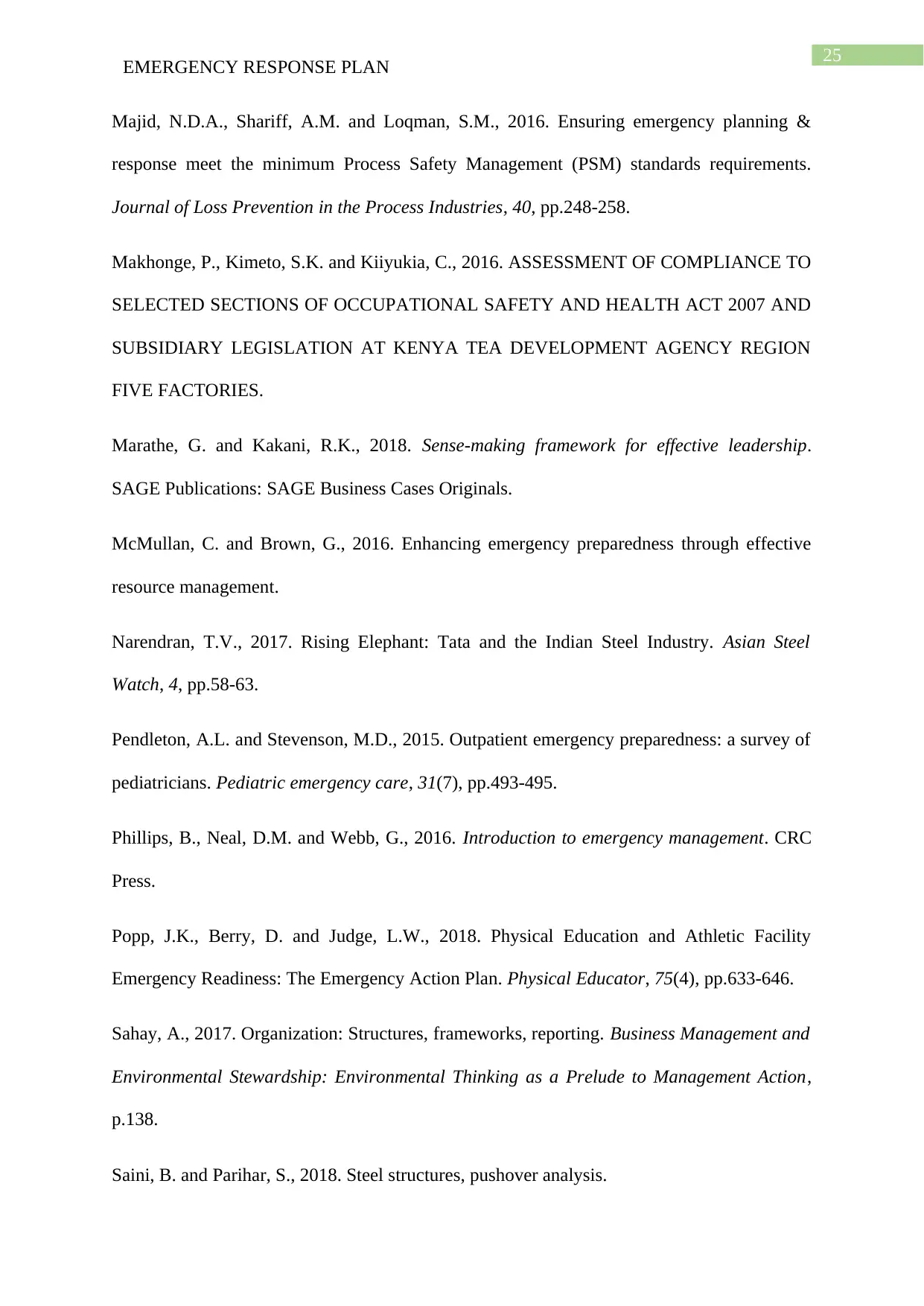
25
EMERGENCY RESPONSE PLAN
Majid, N.D.A., Shariff, A.M. and Loqman, S.M., 2016. Ensuring emergency planning &
response meet the minimum Process Safety Management (PSM) standards requirements.
Journal of Loss Prevention in the Process Industries, 40, pp.248-258.
Makhonge, P., Kimeto, S.K. and Kiiyukia, C., 2016. ASSESSMENT OF COMPLIANCE TO
SELECTED SECTIONS OF OCCUPATIONAL SAFETY AND HEALTH ACT 2007 AND
SUBSIDIARY LEGISLATION AT KENYA TEA DEVELOPMENT AGENCY REGION
FIVE FACTORIES.
Marathe, G. and Kakani, R.K., 2018. Sense-making framework for effective leadership.
SAGE Publications: SAGE Business Cases Originals.
McMullan, C. and Brown, G., 2016. Enhancing emergency preparedness through effective
resource management.
Narendran, T.V., 2017. Rising Elephant: Tata and the Indian Steel Industry. Asian Steel
Watch, 4, pp.58-63.
Pendleton, A.L. and Stevenson, M.D., 2015. Outpatient emergency preparedness: a survey of
pediatricians. Pediatric emergency care, 31(7), pp.493-495.
Phillips, B., Neal, D.M. and Webb, G., 2016. Introduction to emergency management. CRC
Press.
Popp, J.K., Berry, D. and Judge, L.W., 2018. Physical Education and Athletic Facility
Emergency Readiness: The Emergency Action Plan. Physical Educator, 75(4), pp.633-646.
Sahay, A., 2017. Organization: Structures, frameworks, reporting. Business Management and
Environmental Stewardship: Environmental Thinking as a Prelude to Management Action,
p.138.
Saini, B. and Parihar, S., 2018. Steel structures, pushover analysis.
EMERGENCY RESPONSE PLAN
Majid, N.D.A., Shariff, A.M. and Loqman, S.M., 2016. Ensuring emergency planning &
response meet the minimum Process Safety Management (PSM) standards requirements.
Journal of Loss Prevention in the Process Industries, 40, pp.248-258.
Makhonge, P., Kimeto, S.K. and Kiiyukia, C., 2016. ASSESSMENT OF COMPLIANCE TO
SELECTED SECTIONS OF OCCUPATIONAL SAFETY AND HEALTH ACT 2007 AND
SUBSIDIARY LEGISLATION AT KENYA TEA DEVELOPMENT AGENCY REGION
FIVE FACTORIES.
Marathe, G. and Kakani, R.K., 2018. Sense-making framework for effective leadership.
SAGE Publications: SAGE Business Cases Originals.
McMullan, C. and Brown, G., 2016. Enhancing emergency preparedness through effective
resource management.
Narendran, T.V., 2017. Rising Elephant: Tata and the Indian Steel Industry. Asian Steel
Watch, 4, pp.58-63.
Pendleton, A.L. and Stevenson, M.D., 2015. Outpatient emergency preparedness: a survey of
pediatricians. Pediatric emergency care, 31(7), pp.493-495.
Phillips, B., Neal, D.M. and Webb, G., 2016. Introduction to emergency management. CRC
Press.
Popp, J.K., Berry, D. and Judge, L.W., 2018. Physical Education and Athletic Facility
Emergency Readiness: The Emergency Action Plan. Physical Educator, 75(4), pp.633-646.
Sahay, A., 2017. Organization: Structures, frameworks, reporting. Business Management and
Environmental Stewardship: Environmental Thinking as a Prelude to Management Action,
p.138.
Saini, B. and Parihar, S., 2018. Steel structures, pushover analysis.
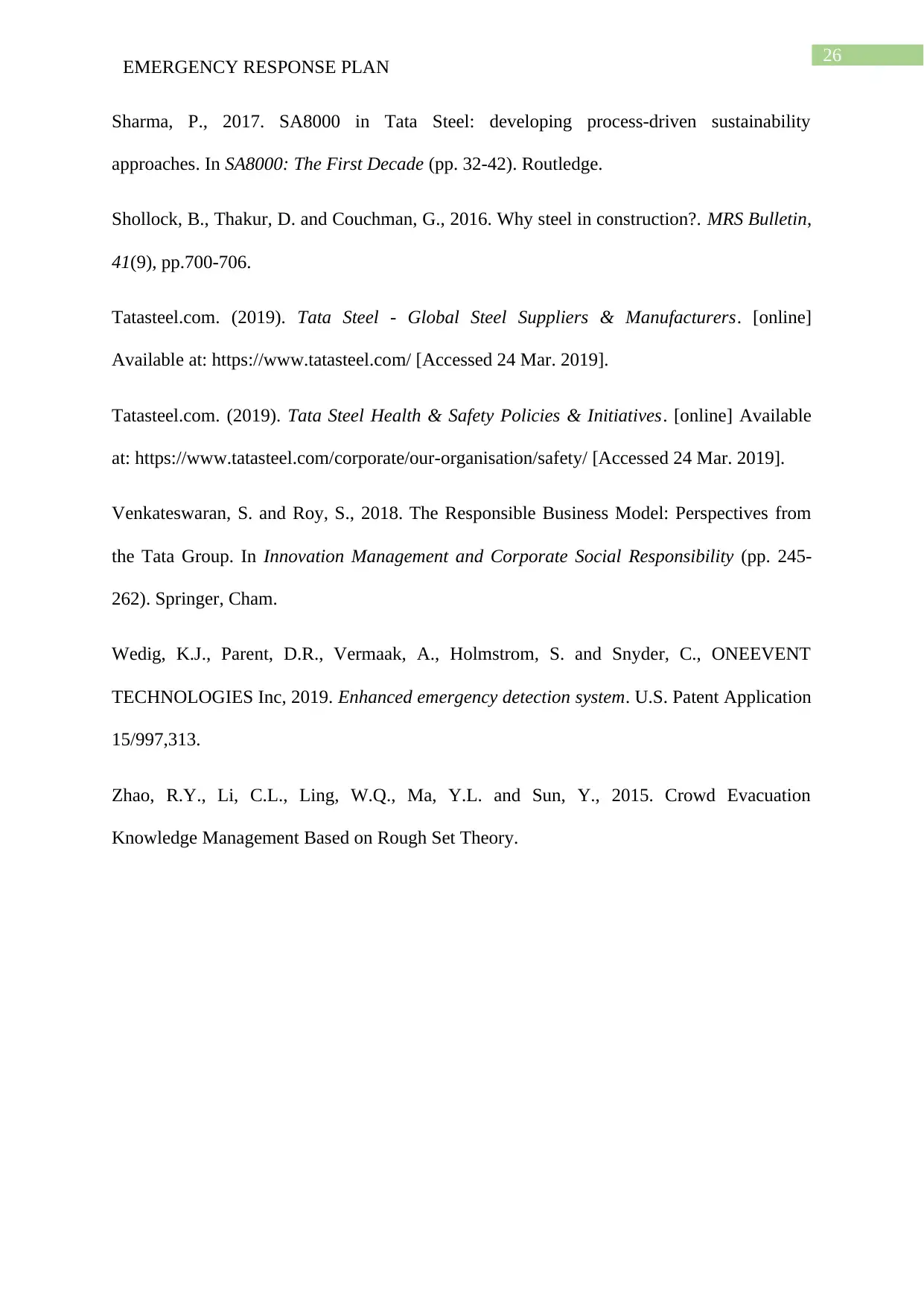
26
EMERGENCY RESPONSE PLAN
Sharma, P., 2017. SA8000 in Tata Steel: developing process-driven sustainability
approaches. In SA8000: The First Decade (pp. 32-42). Routledge.
Shollock, B., Thakur, D. and Couchman, G., 2016. Why steel in construction?. MRS Bulletin,
41(9), pp.700-706.
Tatasteel.com. (2019). Tata Steel - Global Steel Suppliers & Manufacturers. [online]
Available at: https://www.tatasteel.com/ [Accessed 24 Mar. 2019].
Tatasteel.com. (2019). Tata Steel Health & Safety Policies & Initiatives. [online] Available
at: https://www.tatasteel.com/corporate/our-organisation/safety/ [Accessed 24 Mar. 2019].
Venkateswaran, S. and Roy, S., 2018. The Responsible Business Model: Perspectives from
the Tata Group. In Innovation Management and Corporate Social Responsibility (pp. 245-
262). Springer, Cham.
Wedig, K.J., Parent, D.R., Vermaak, A., Holmstrom, S. and Snyder, C., ONEEVENT
TECHNOLOGIES Inc, 2019. Enhanced emergency detection system. U.S. Patent Application
15/997,313.
Zhao, R.Y., Li, C.L., Ling, W.Q., Ma, Y.L. and Sun, Y., 2015. Crowd Evacuation
Knowledge Management Based on Rough Set Theory.
EMERGENCY RESPONSE PLAN
Sharma, P., 2017. SA8000 in Tata Steel: developing process-driven sustainability
approaches. In SA8000: The First Decade (pp. 32-42). Routledge.
Shollock, B., Thakur, D. and Couchman, G., 2016. Why steel in construction?. MRS Bulletin,
41(9), pp.700-706.
Tatasteel.com. (2019). Tata Steel - Global Steel Suppliers & Manufacturers. [online]
Available at: https://www.tatasteel.com/ [Accessed 24 Mar. 2019].
Tatasteel.com. (2019). Tata Steel Health & Safety Policies & Initiatives. [online] Available
at: https://www.tatasteel.com/corporate/our-organisation/safety/ [Accessed 24 Mar. 2019].
Venkateswaran, S. and Roy, S., 2018. The Responsible Business Model: Perspectives from
the Tata Group. In Innovation Management and Corporate Social Responsibility (pp. 245-
262). Springer, Cham.
Wedig, K.J., Parent, D.R., Vermaak, A., Holmstrom, S. and Snyder, C., ONEEVENT
TECHNOLOGIES Inc, 2019. Enhanced emergency detection system. U.S. Patent Application
15/997,313.
Zhao, R.Y., Li, C.L., Ling, W.Q., Ma, Y.L. and Sun, Y., 2015. Crowd Evacuation
Knowledge Management Based on Rough Set Theory.
1 out of 27
Related Documents
Your All-in-One AI-Powered Toolkit for Academic Success.
+13062052269
info@desklib.com
Available 24*7 on WhatsApp / Email
![[object Object]](/_next/static/media/star-bottom.7253800d.svg)
Unlock your academic potential
© 2024 | Zucol Services PVT LTD | All rights reserved.





